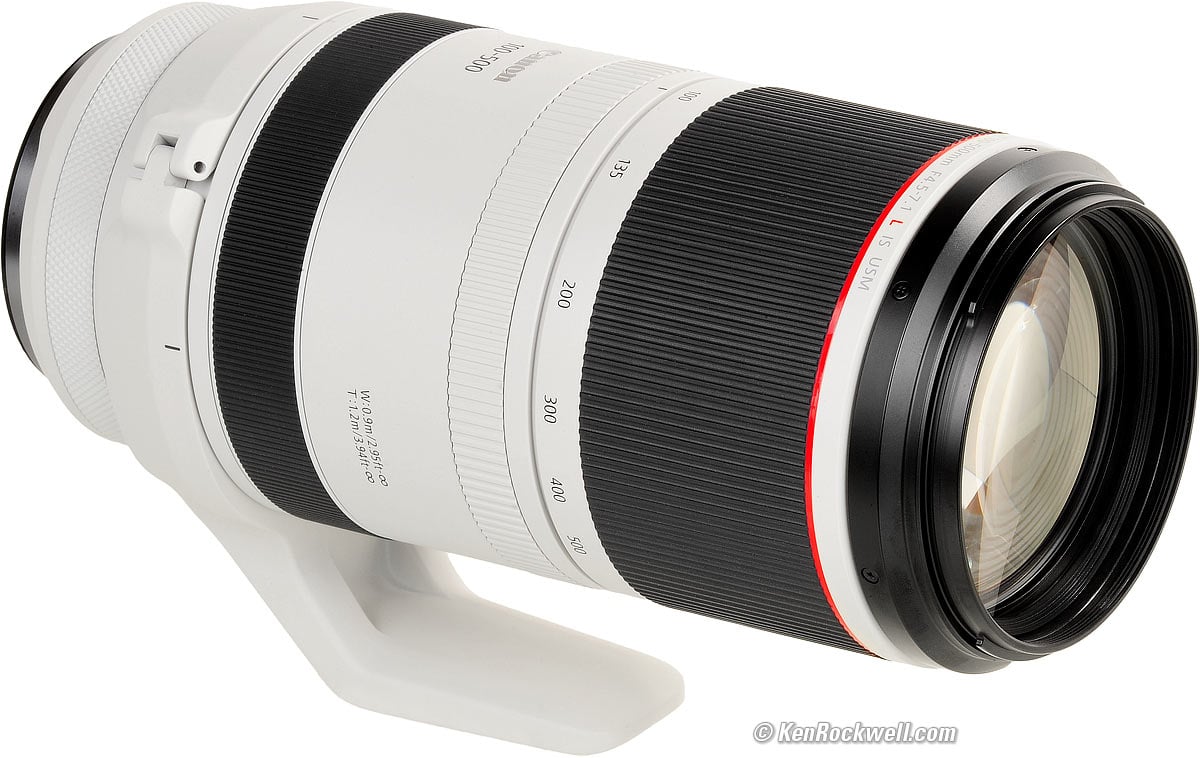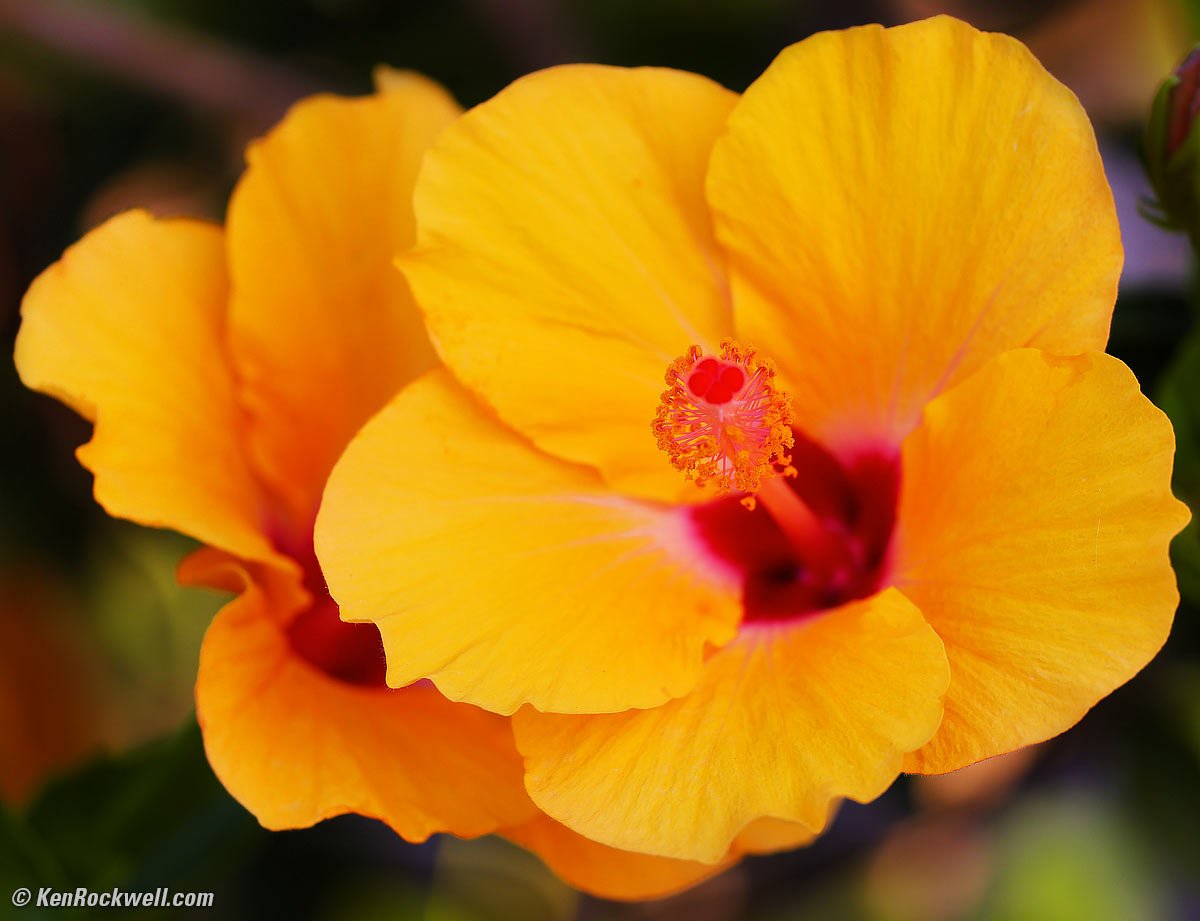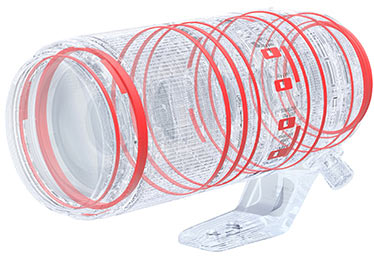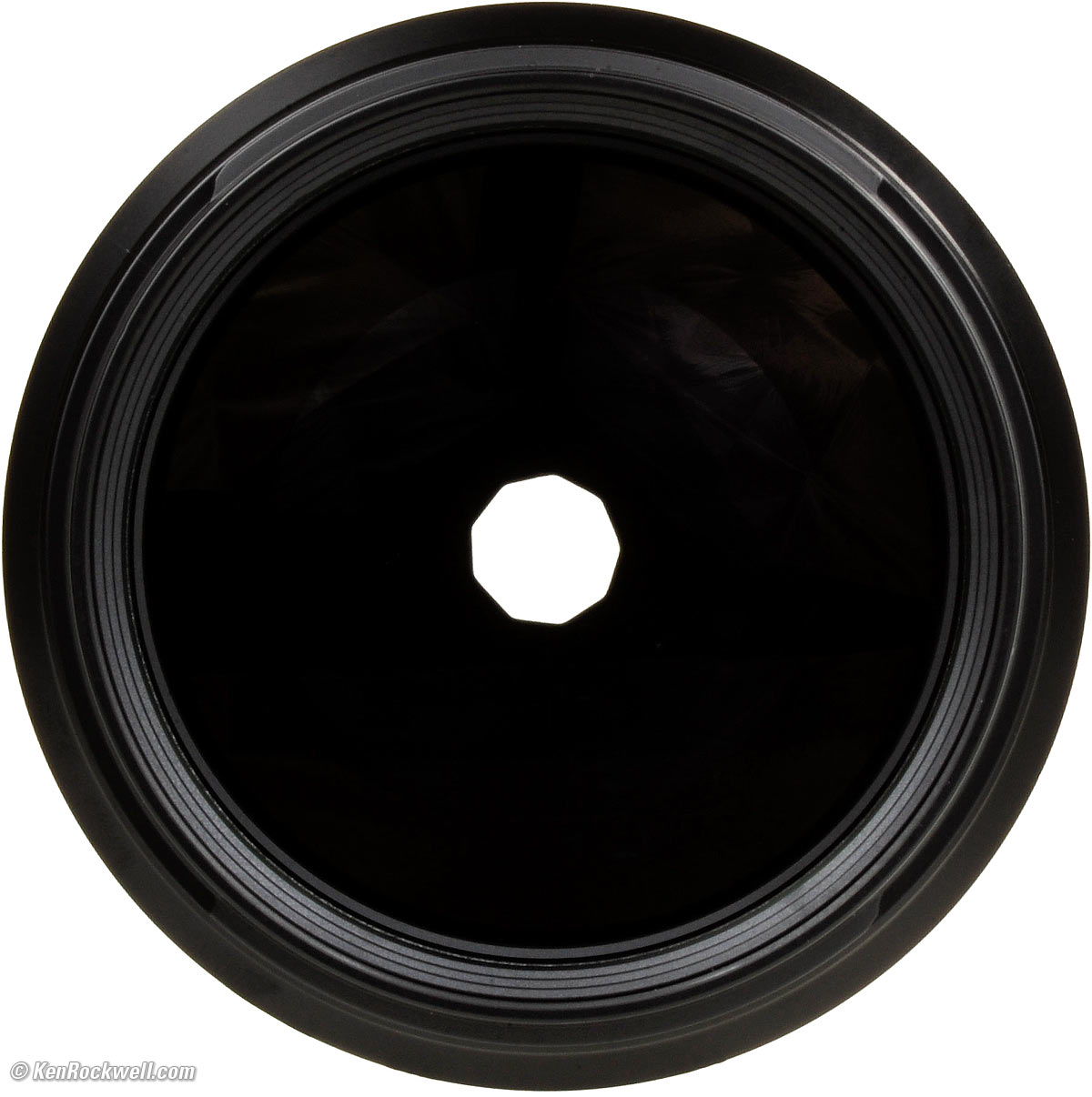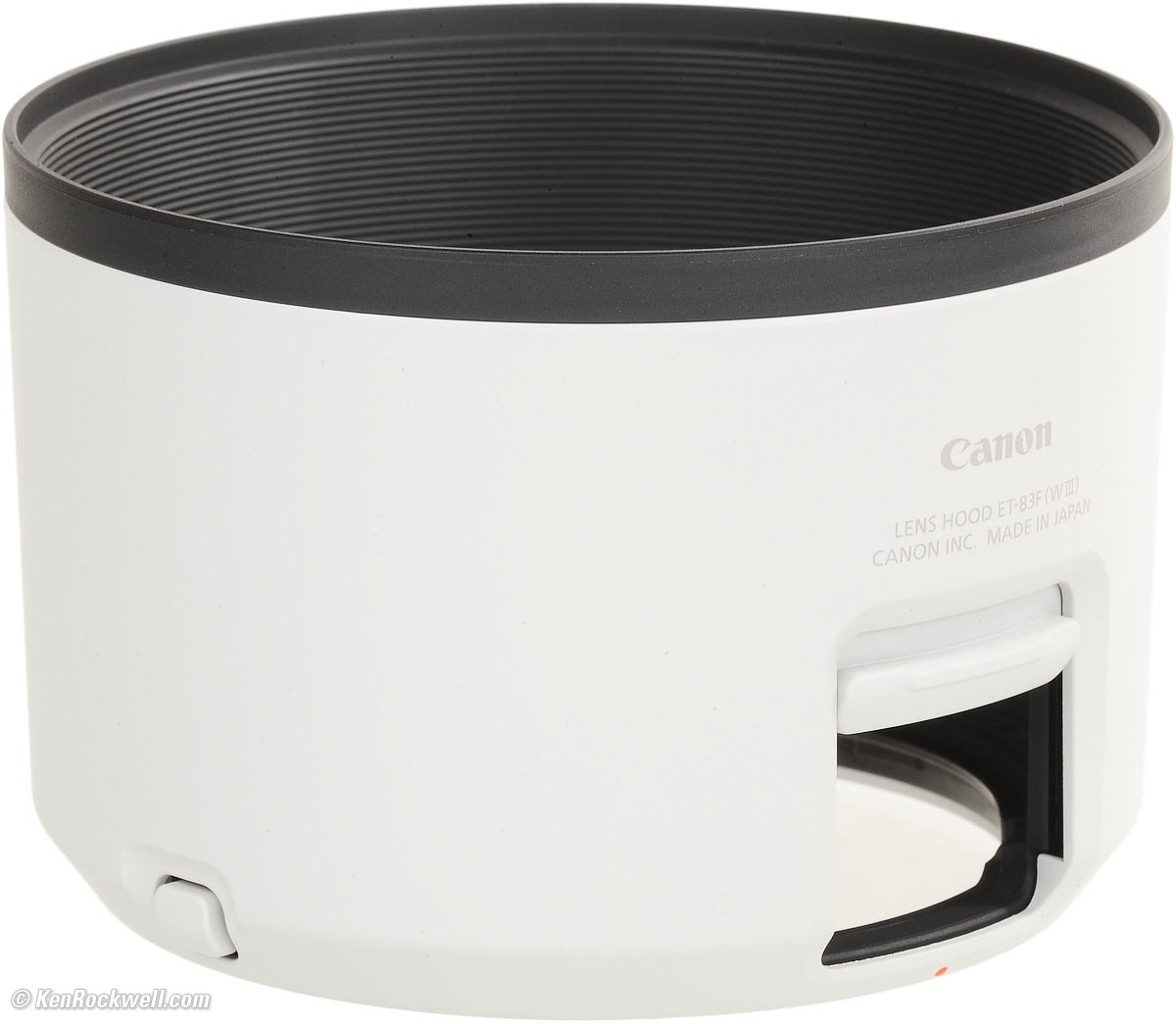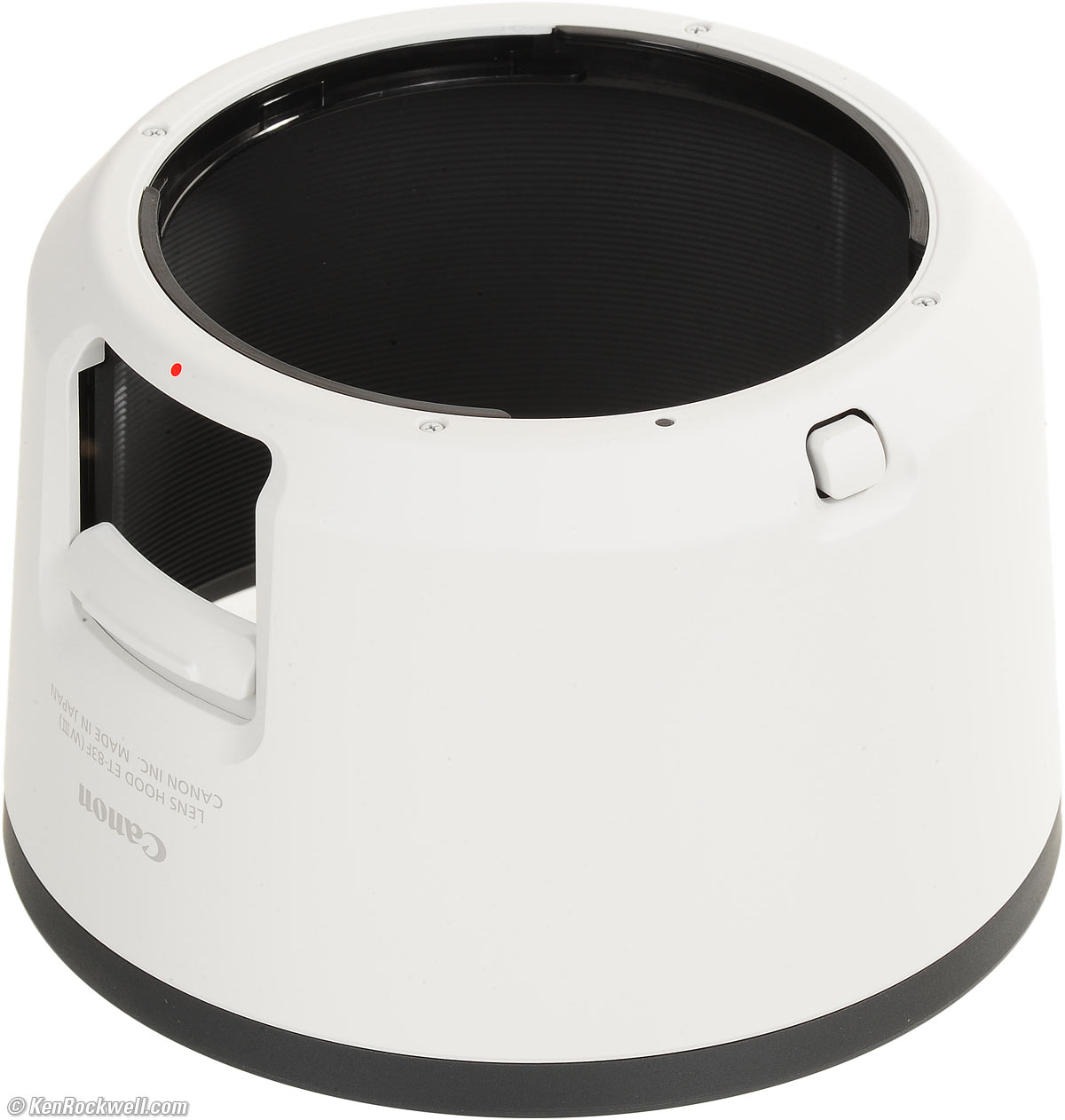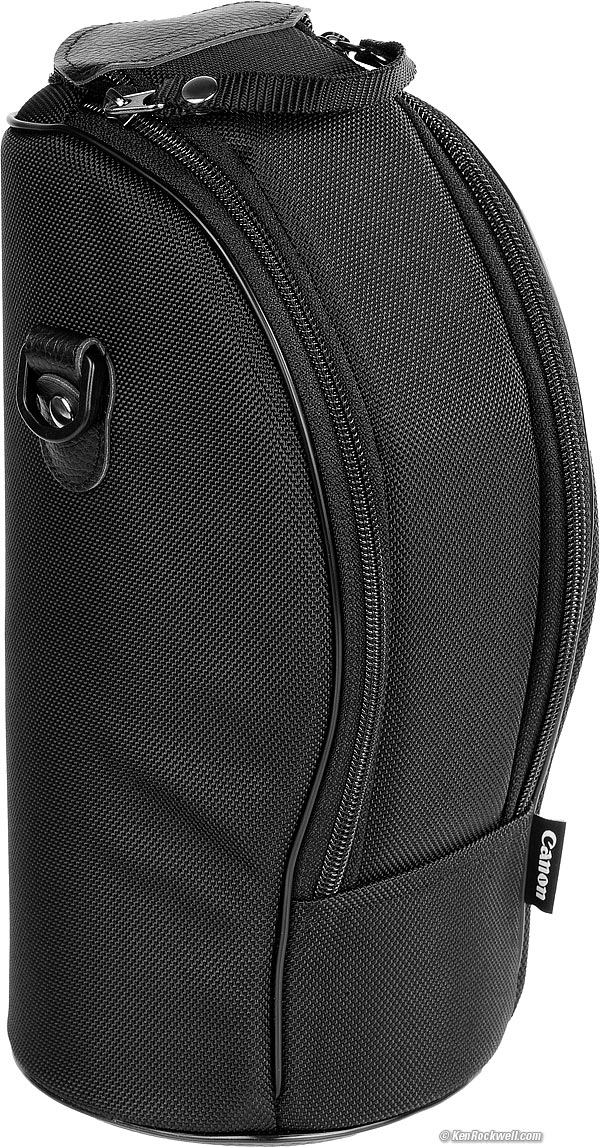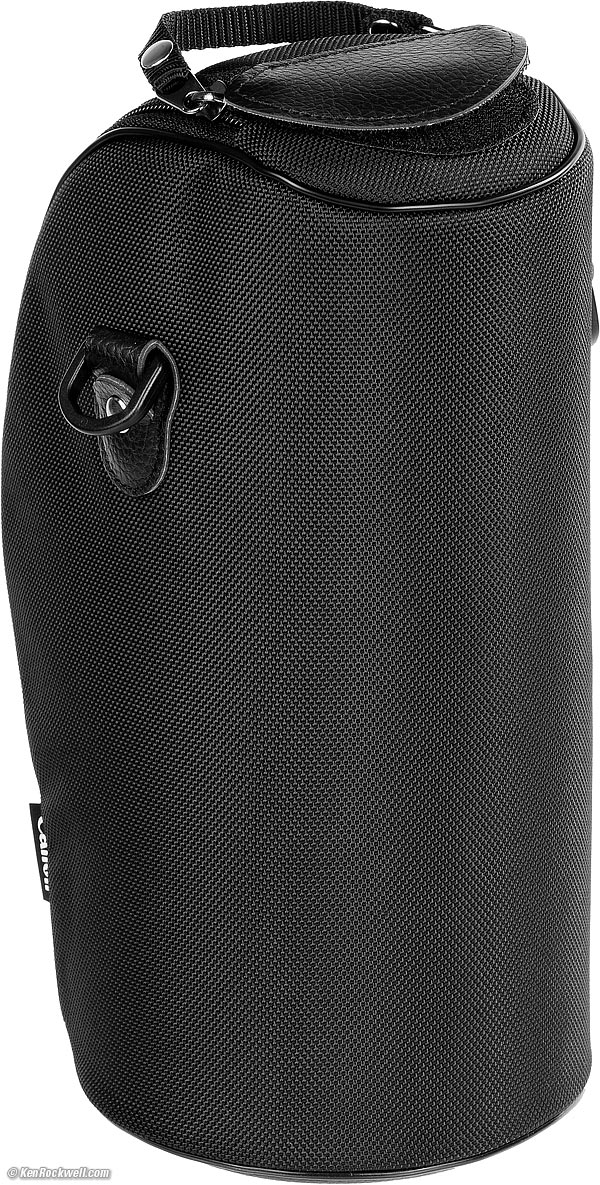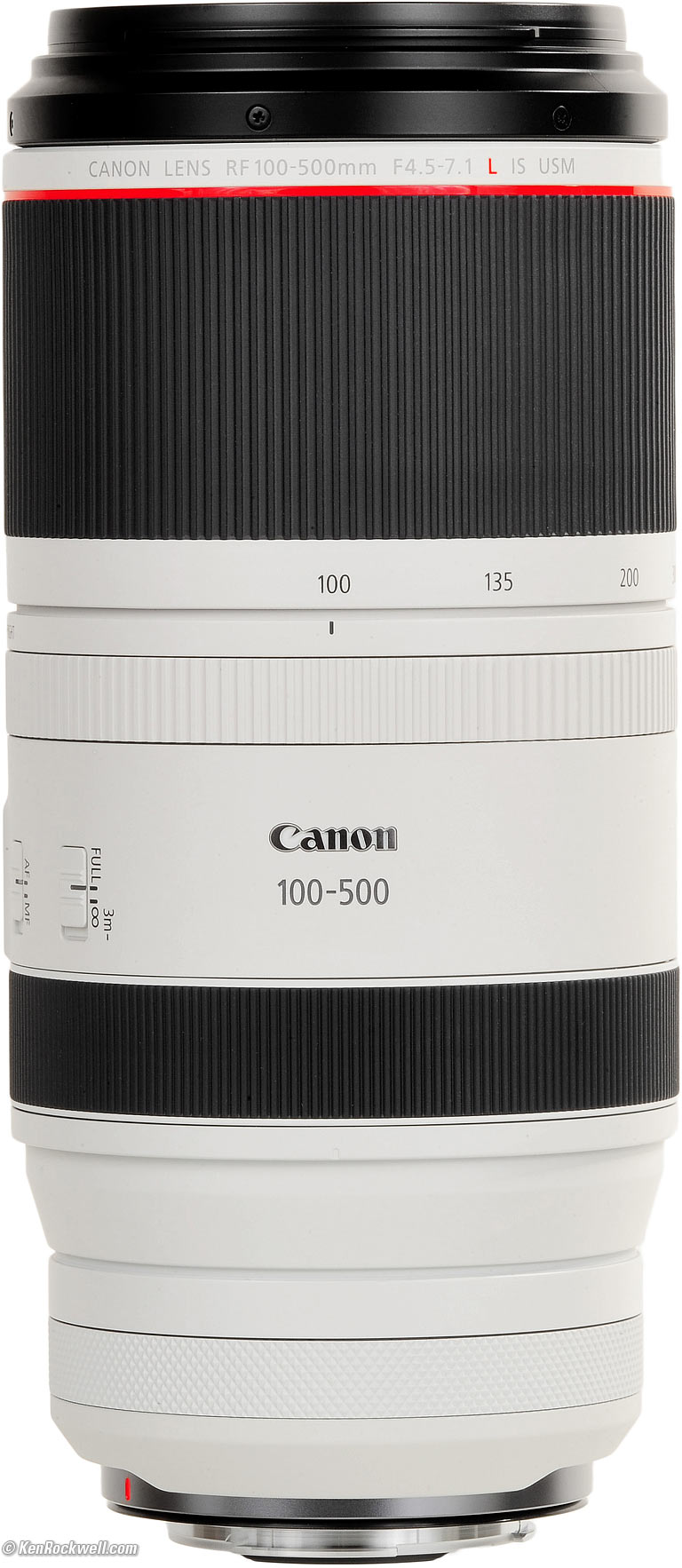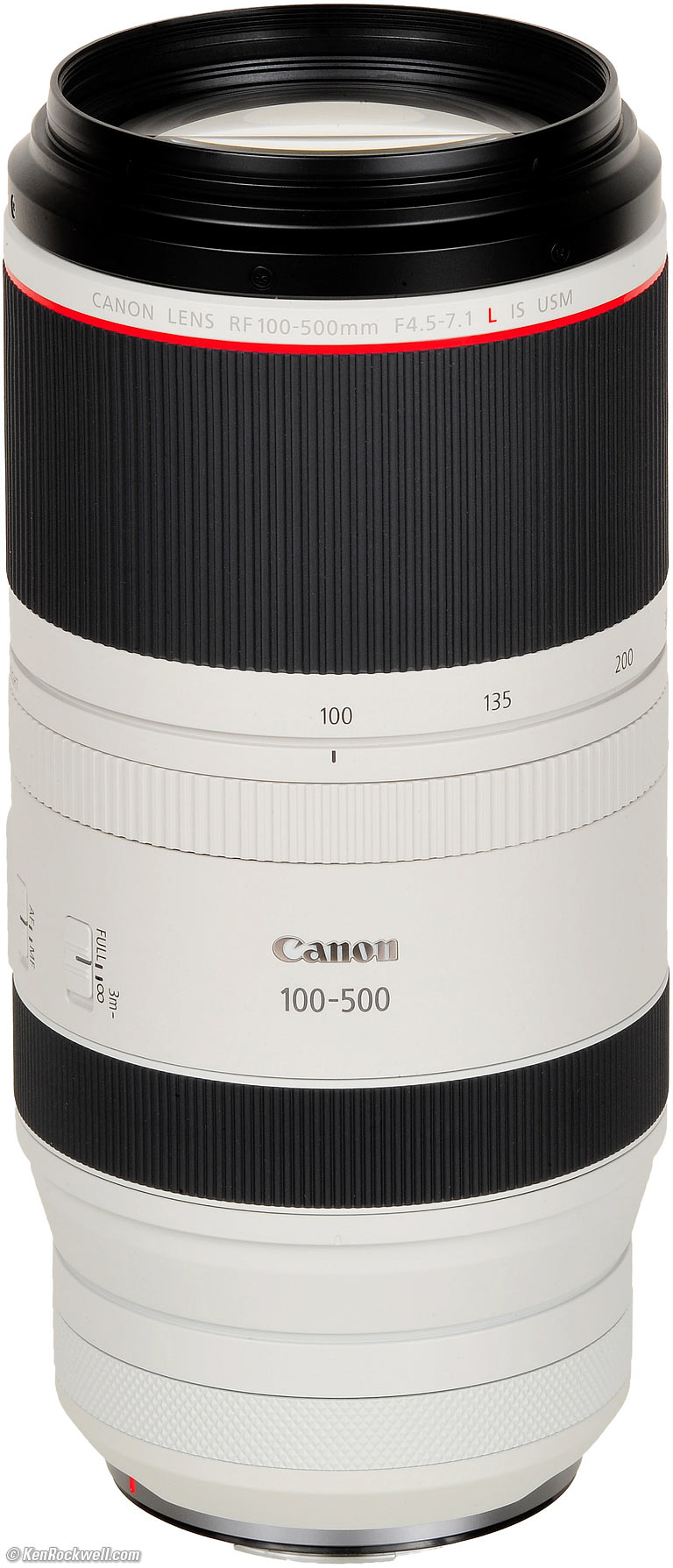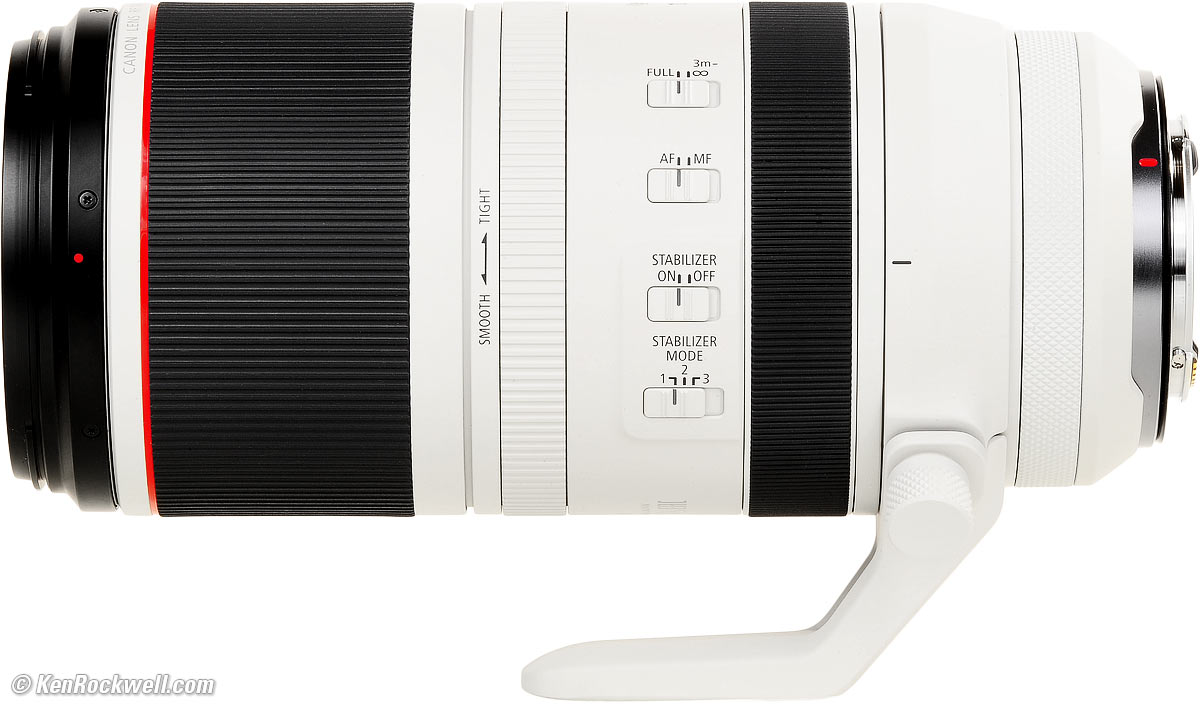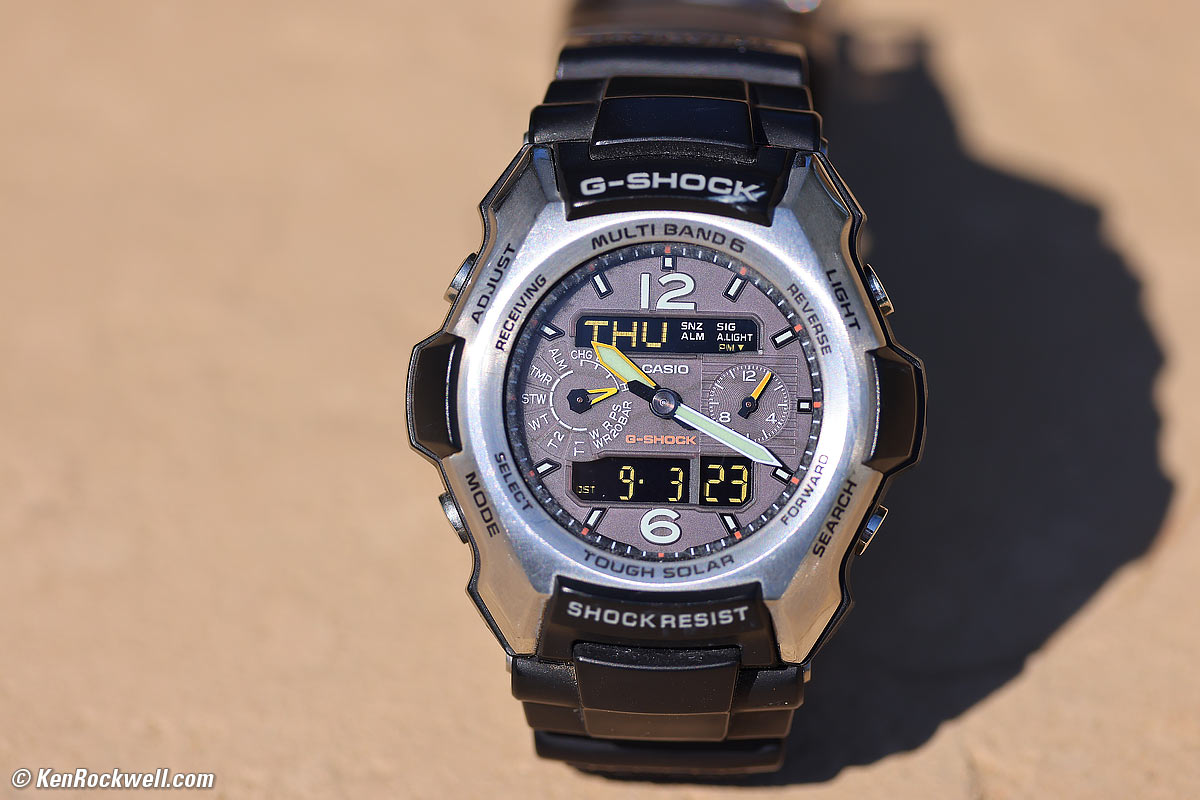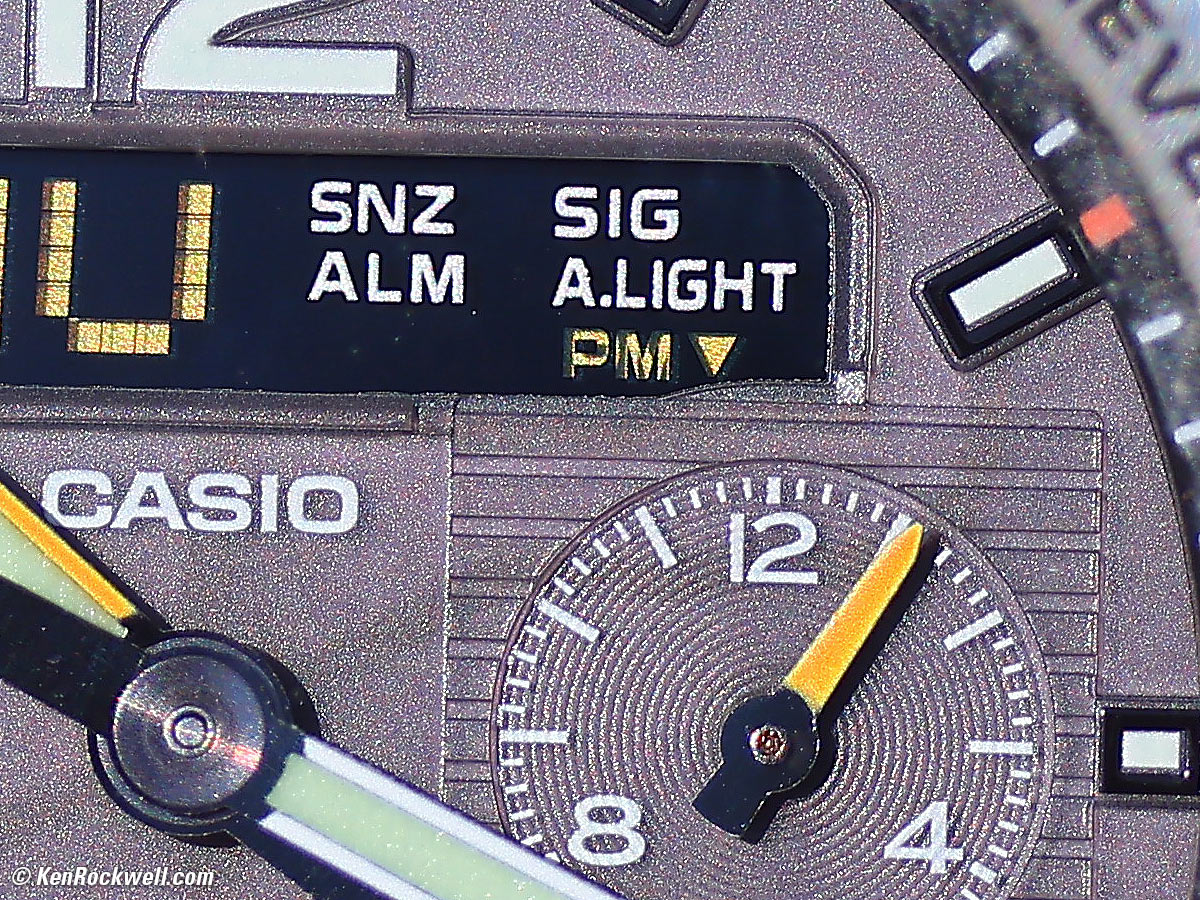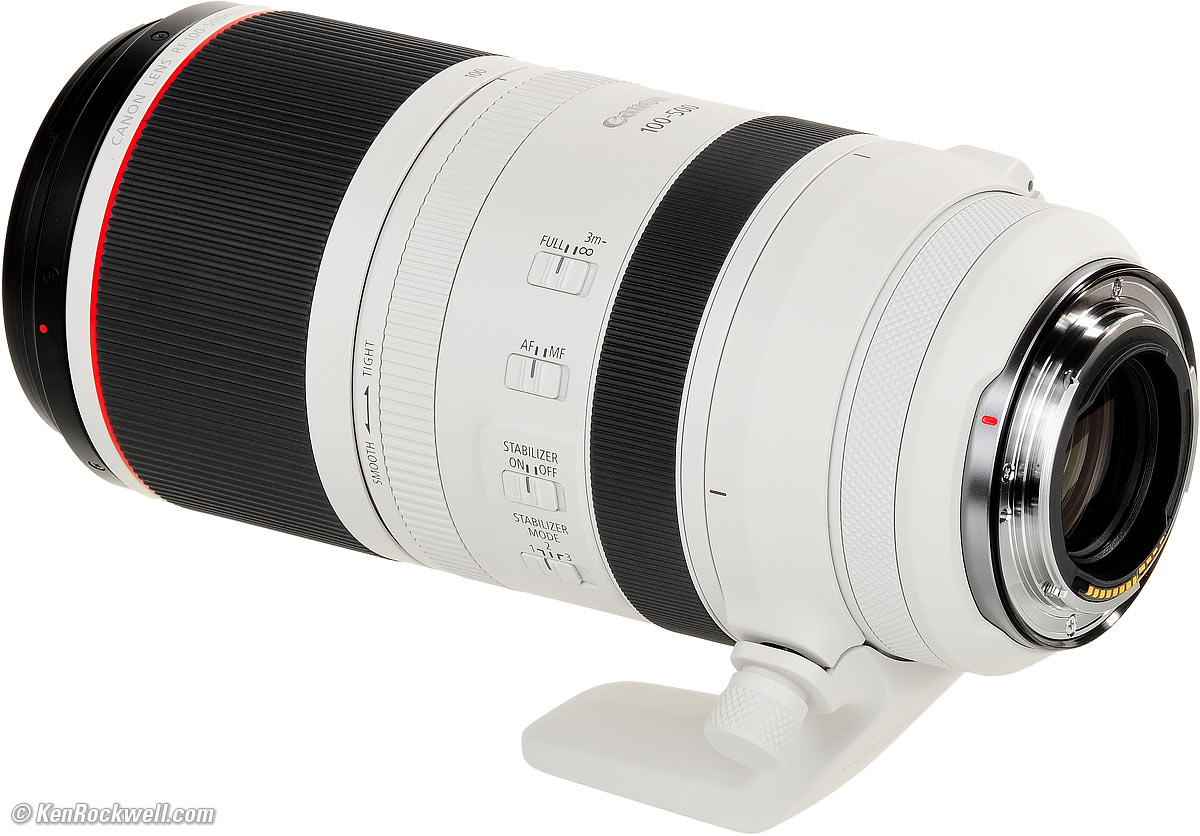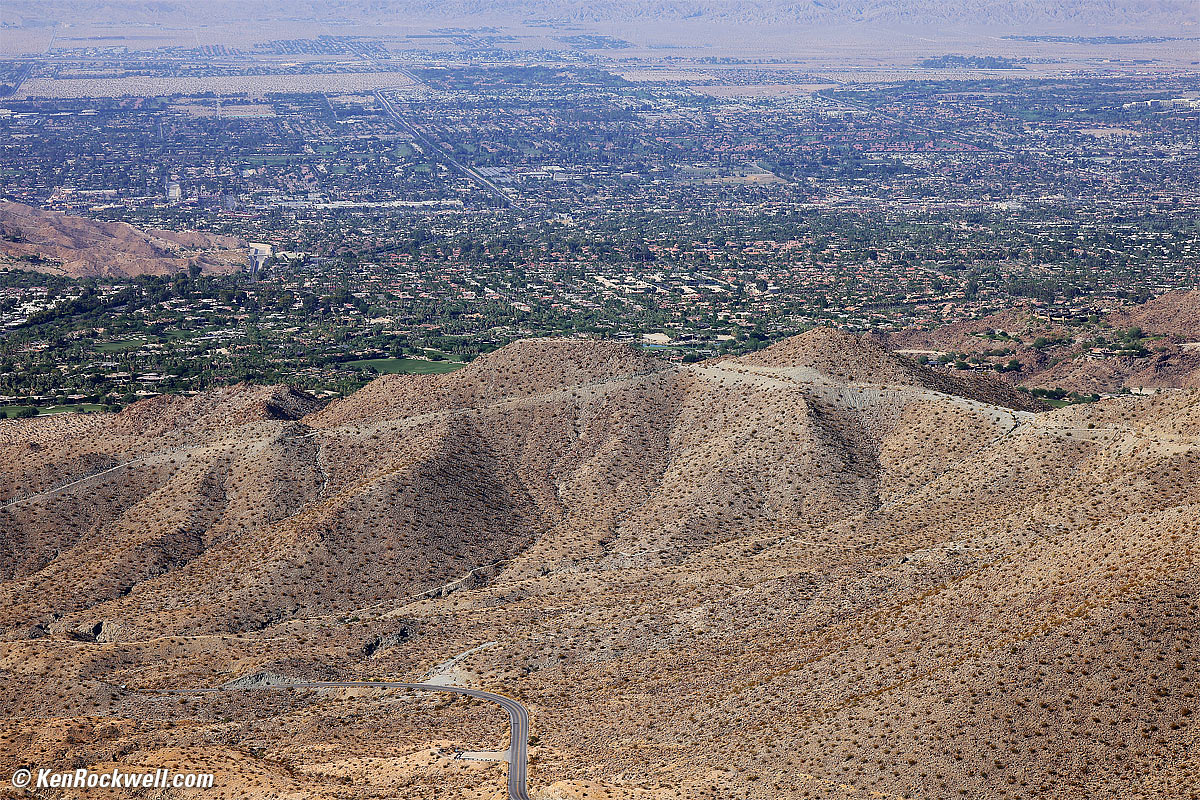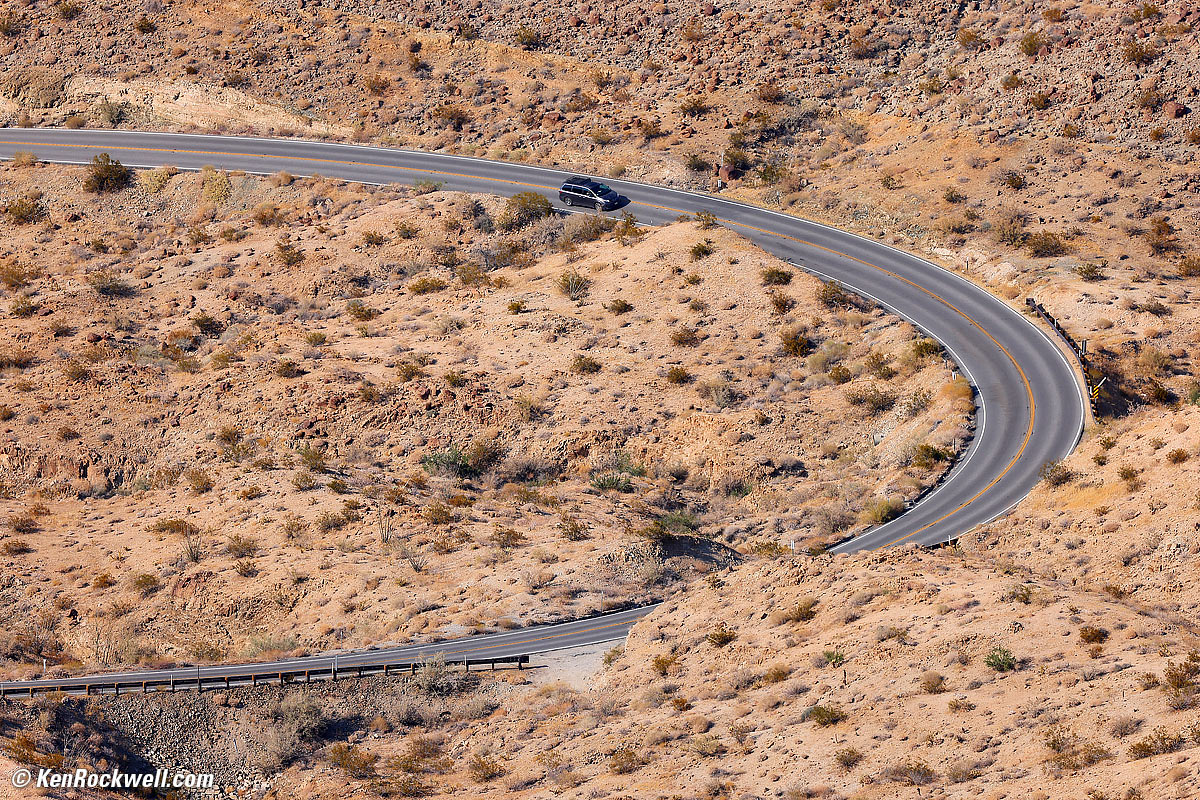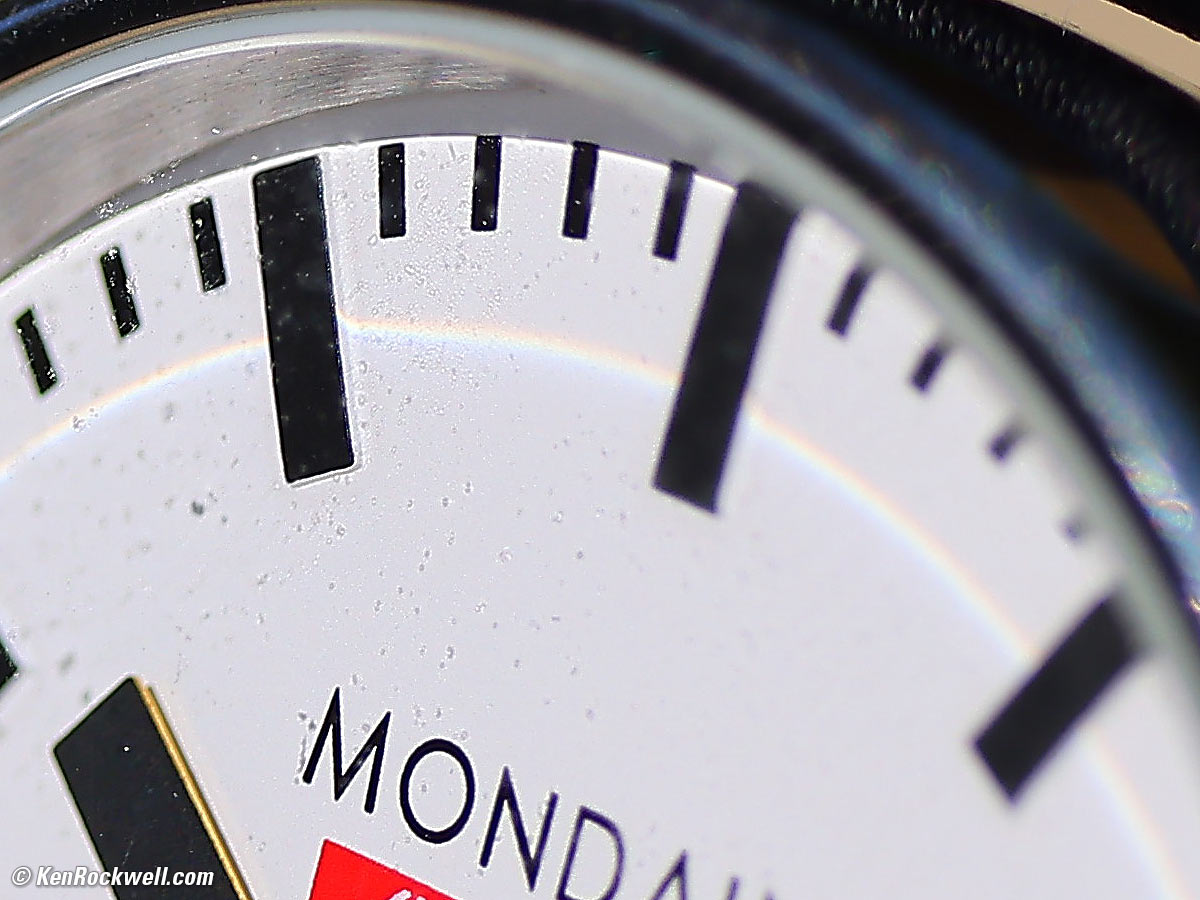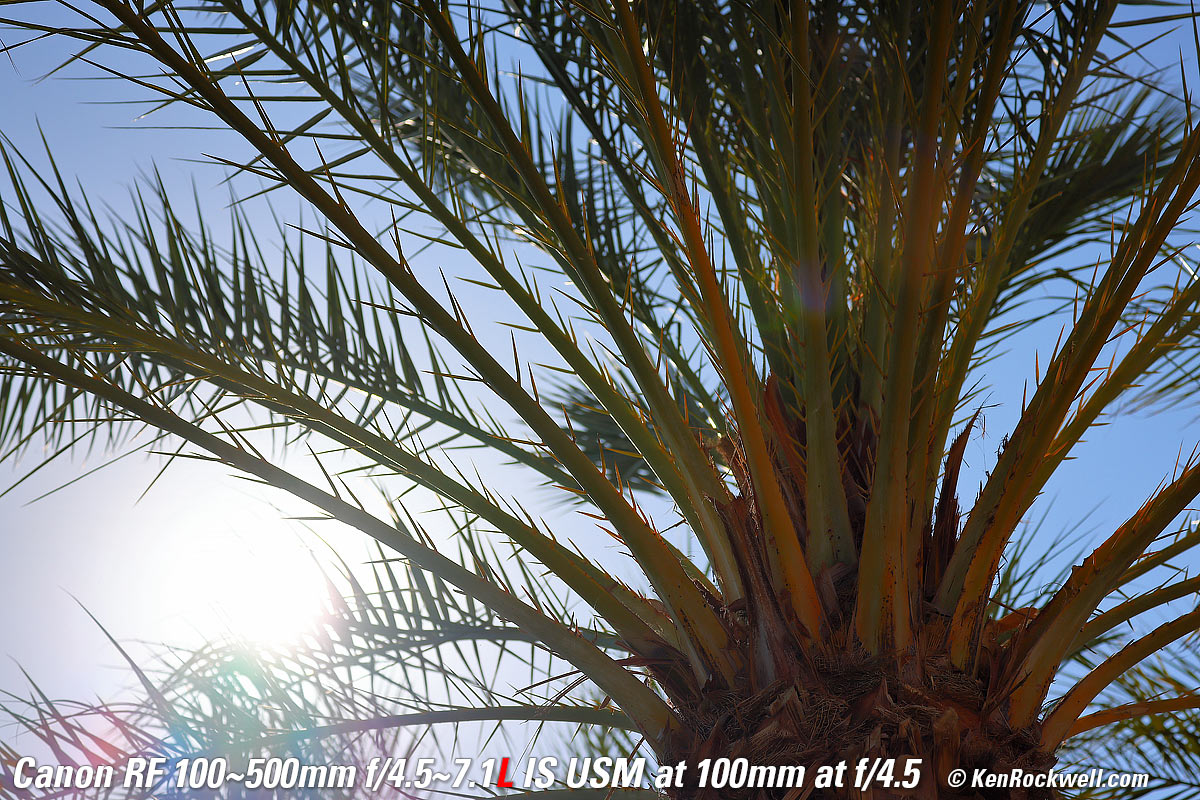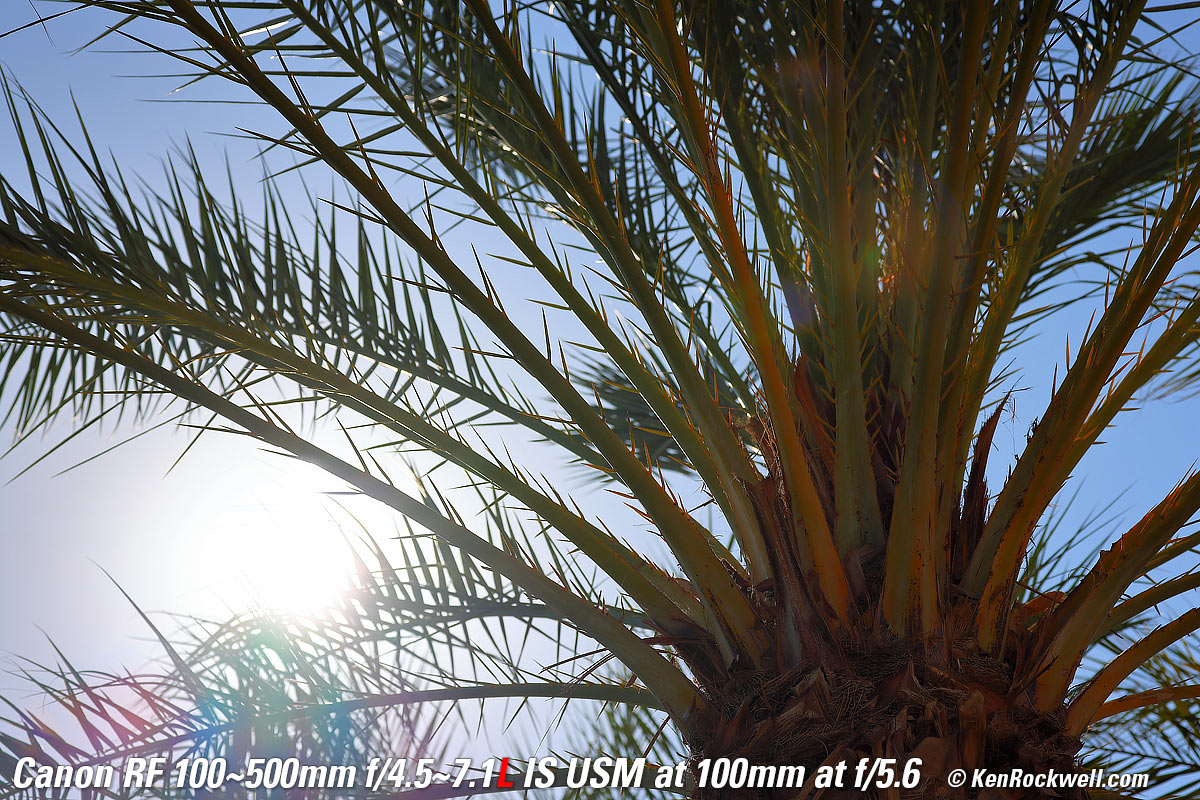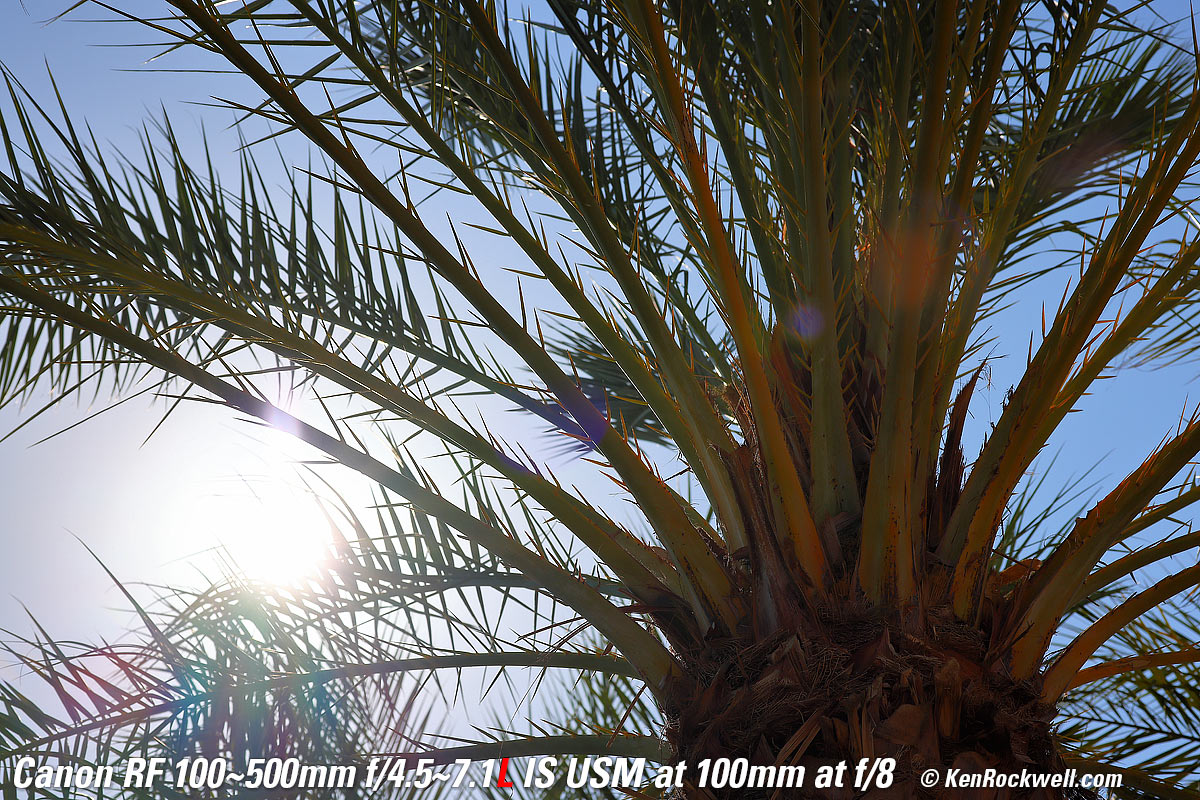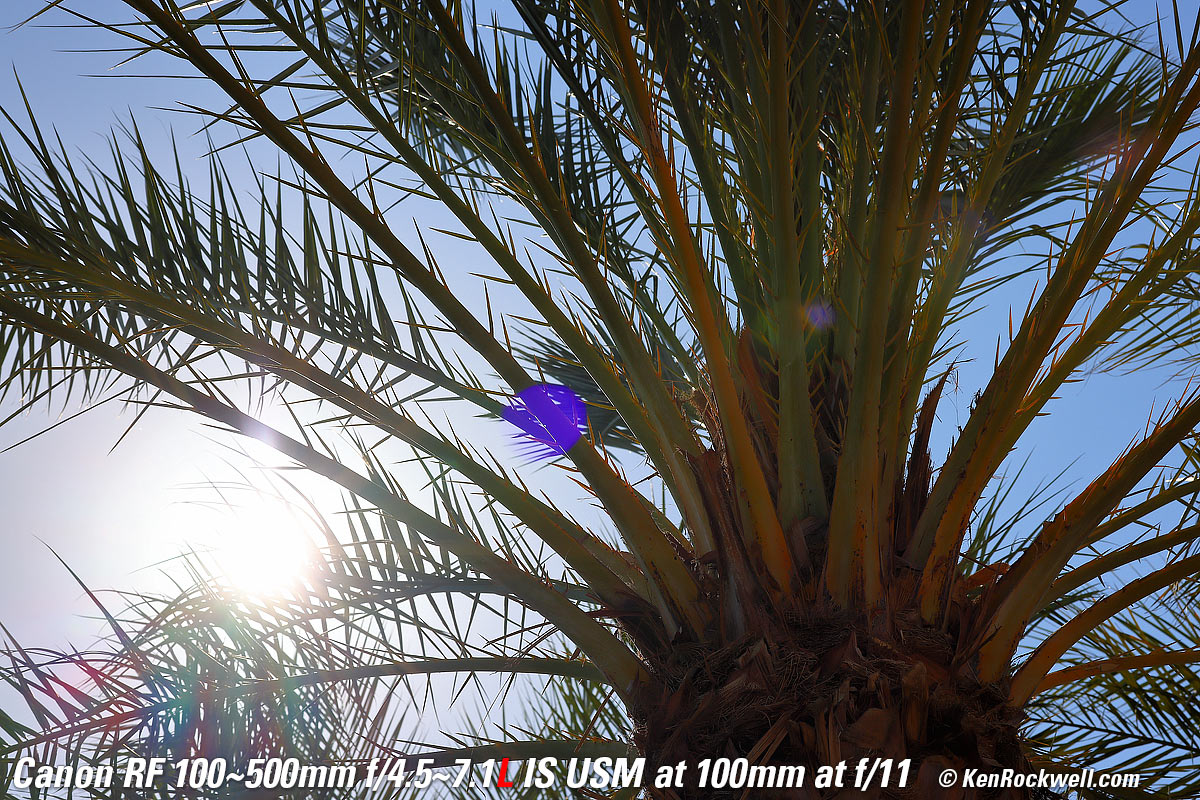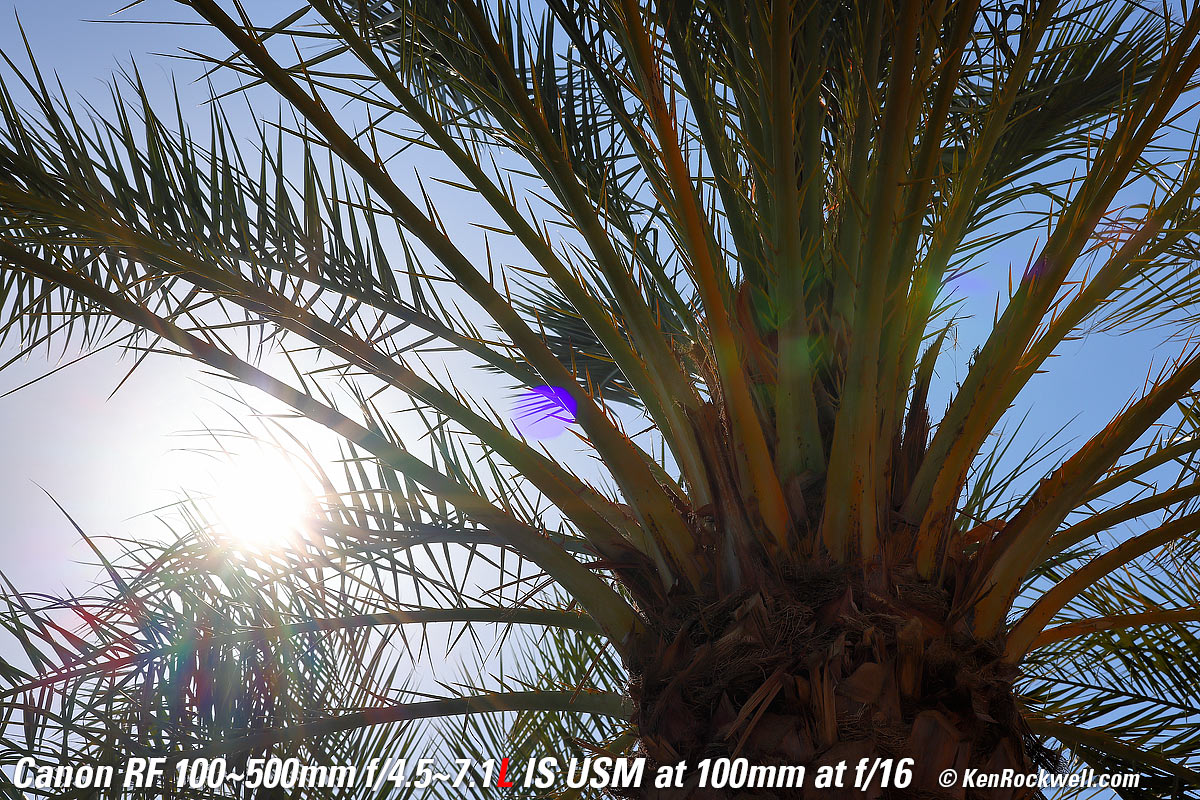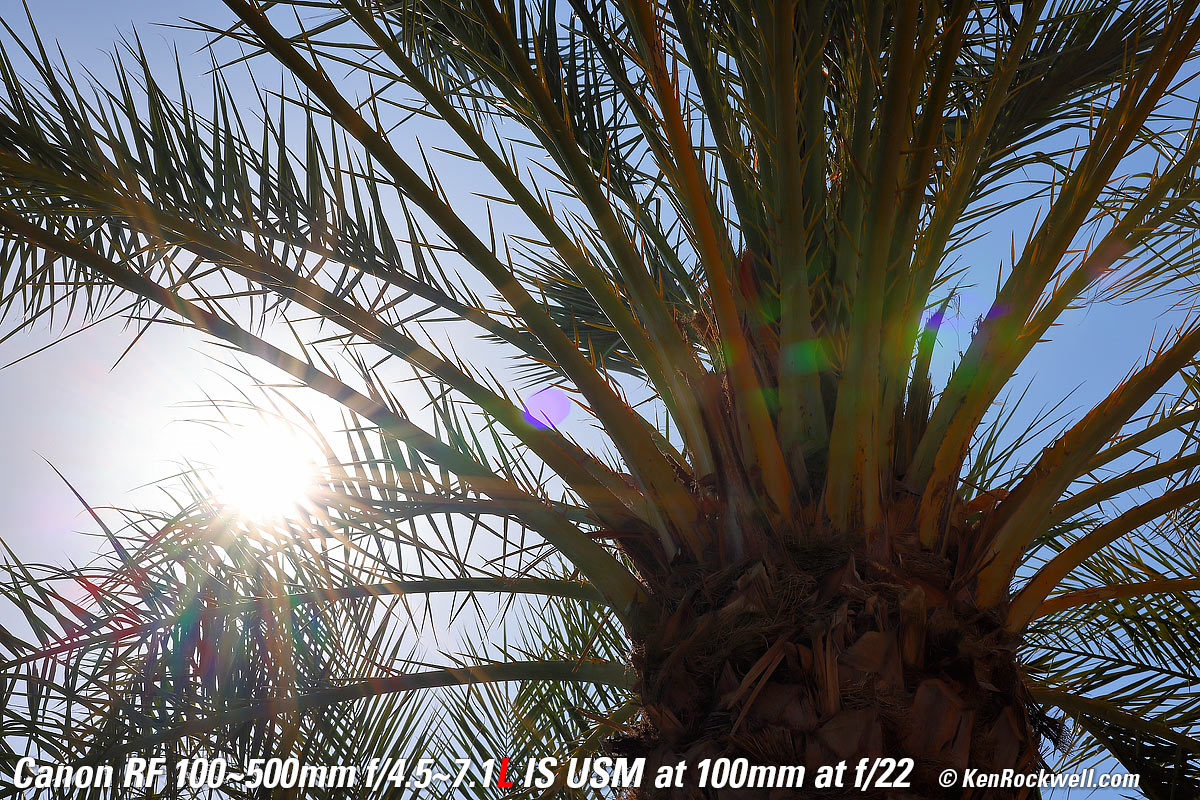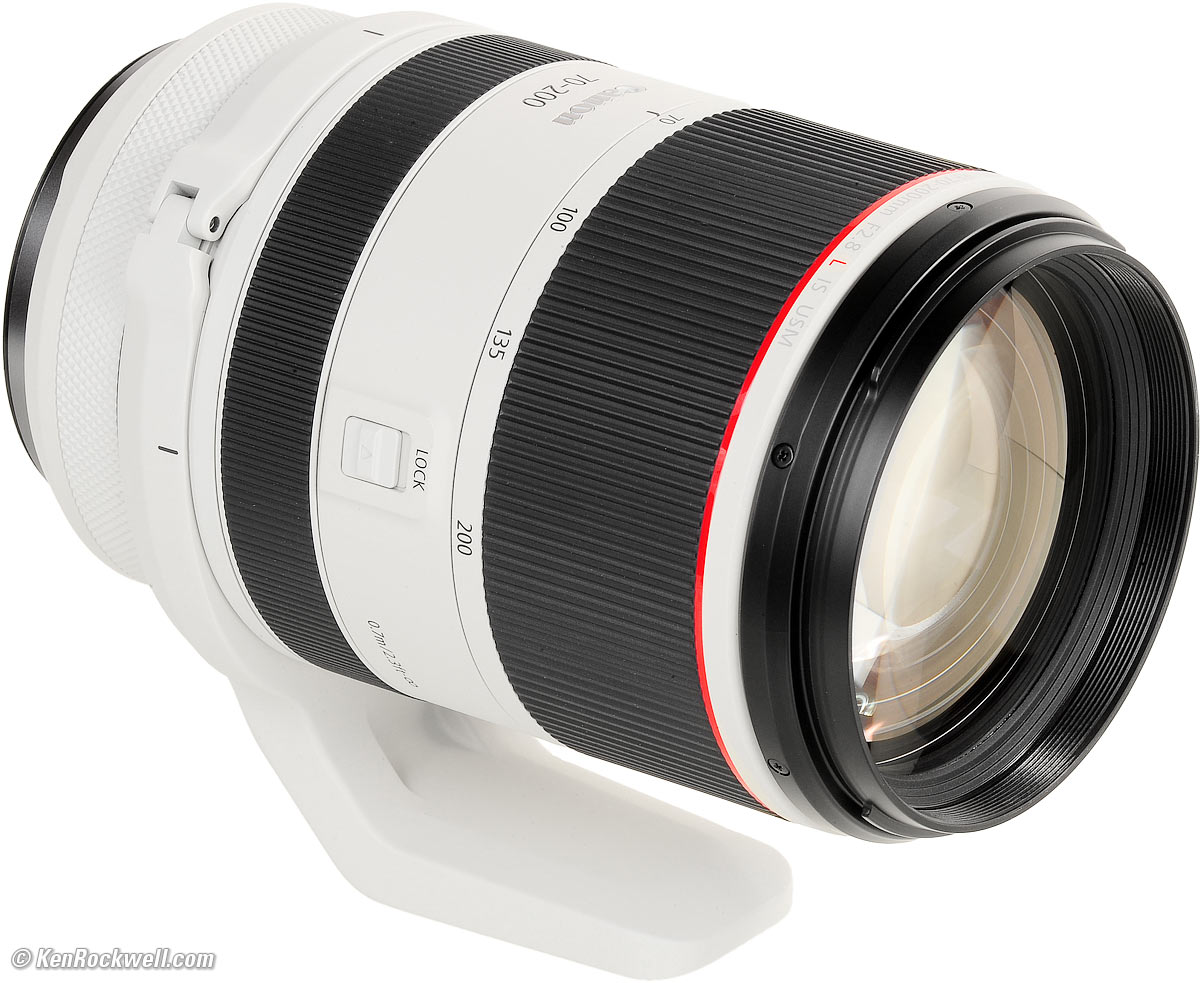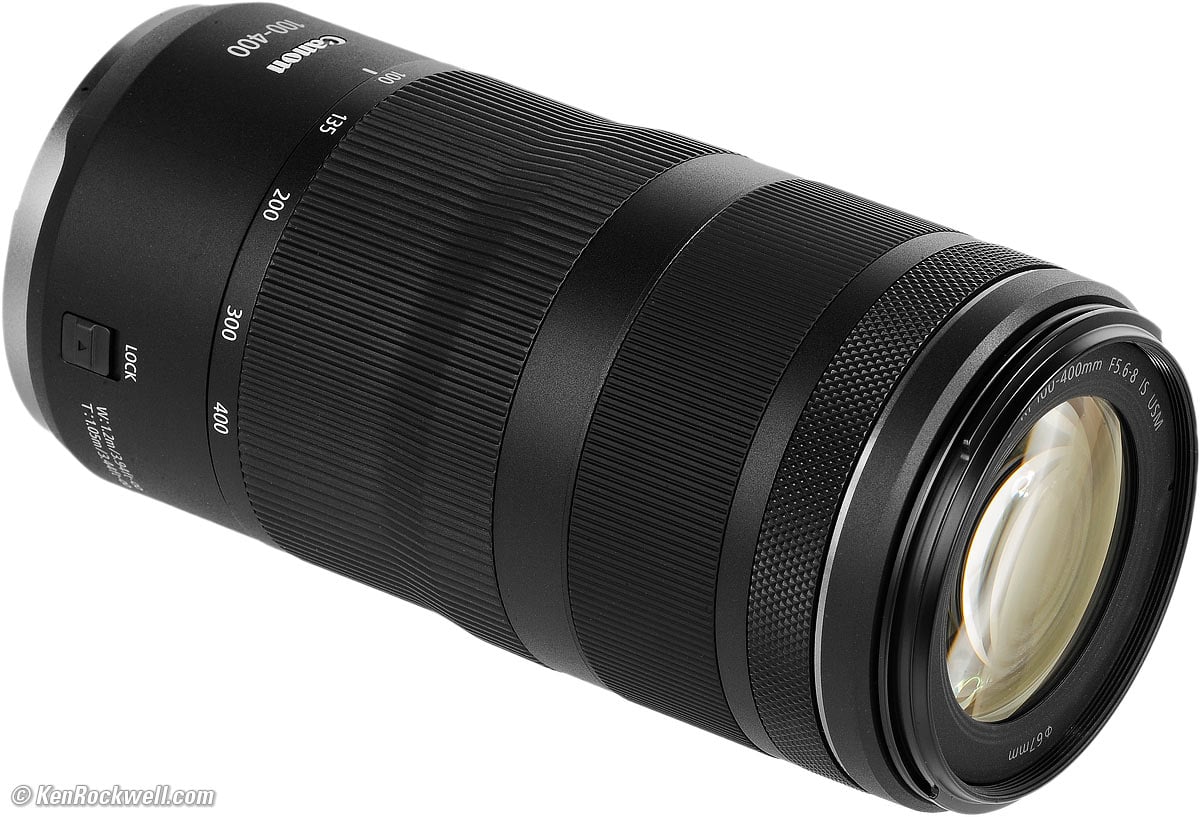Canon RF 100‑500mm
f/4.5‑7.1L IS USM
Full-Frame Mirrorless
Ultra-Sharp & Ultra-Close Focussing
Sample Images Intro Compatibility
Specifications Performance Compared
R3 R5 R5C R6 II R6 R R8 RP R7 R10 R50 R100
Bodies Compared RF Lenses EF Lenses Flash
Canon RF 100-500mm f/4.5-7.1L IS USM (77mm filters, 54.0 oz./1,530g with tripod collar as shown, 48.3 oz./1,370 g without collar, 2.9-3.9'/0.9-1.2 meters close focus, $2,899). bigger. I got mine at B&H. I'd also get it at Adorama, at Amazon or at Crutchfield, or used at eBay if you know How to Win at eBay.
This all-content, junk-free website's biggest source of support is when you use those or any of these links to approved sources when you get anything, regardless of the country in which you live. Thanks for helping me help you! Ken.
October 2022 Better Pictures Canon Reviews Mirrorless RF Lenses EF Lenses Flash All Reviews
The EF 100-400mm L IS II also works magnificently on Canon's mirrorless cameras with an EF to RF adapter ring, and costs much less, is just as sharp and focuses just as close and just as fast. More at Compared.
The RF 100-400mm IS USM is just as sharp, and much smaller, lighter and far less expensive — and takes pretty much the same pictures. See Compared.
Sample Images top
Sample Images Intro Compatibility
Specifications Performance Compared
These are just snapshots and there are many more throughout the review; my real work is in my Gallery.
More samples at Bokeh, Macro, Sharpness and Spherochromatism.
These are all shot hand-held as NORMAL JPGs; no tripods, FINE JPGs or RAW CR3 files were used or needed.
Yellow Hibiscus, 6:05 PM, 01 September 2020. Canon EOS R5, Canon RF 100-500mm L IS USM at 270mm wide-open at f/5.6 hand-held at 1/320 at Auto ISO 200 with -0.3 stops of exposure compensation (LV 12.4), Perfectly Clear. bigger, full resolution or camera-original © JPG file.
Fountain in Afternoon Light, 5:57 PM, 03 September 2020. Canon EOS R6 in square-crop mode, Canon RF 100-500mm L IS USM at 167mm wide-open at f/5 hand-held at 1/250 at Auto ISO 100, -0.3 stops exposure compensation (LV 12.6), exactly as shot. bigger or camera-original © JPG file.
Fuzzy Plant in Afternoon Light, 6:00 PM, September 2020. Canon EOS R6 in square-crop mode, Canon RF 100-500mm L IS USM at 145 mm at f/7.1 hand-held at 1/400 at Auto ISO 100, -0.3 stops exposure compensation (LV 14¼), Perfectly Clear. bigger or camera-original © JPG file.
1,200 × 900 pixel (3× magnification) crop from above. bigger or camera-original © JPG file.
If this 1,200 × 900 pixel crop is about 3" (7.5cm) wide on your screen, the complete image would print at 9¼ × 9¼ " (25 × 25 cm) at this same magnification.
If this 1,200 × 900 pixel crop is about 6" (15cm) wide on your screen, the complete image would print at 18½ × 18½" (50 × 50 cm) at this same magnification.
If this 1,200 × 900 pixel crop is about 12" (30cm) wide on your screen, the complete image would print at 37 × 37" (1 × 1 meters) at this same magnification.
End of Days, 6:00 PM, 07 September 2020. Canon EOS R5 in square-crop mode, Canon RF 100-500mm L IS USM at 135 mm at f/6.3 hand-held at 1/320 at Auto ISO 100, -1.0 stops exposure compensation (LV 13¾), exaclty as shot. bigger or camera-original © JPG file.
Palms, 8:07 AM, 15 September 2020. Canon EOS R6, Canon RF 100-500mm L IS USM at 223 mm at f/7.1 hand-held at 1/500 at Auto ISO 100, -0.7 stops exposure compensation (LV 14.6), Perfectly Clear. bigger, full-resolution or camera-original © JPG file.
Introduction top
Sample Images Intro Compatibility
Specifications Performance Compared
|
I buy only from these approved sources. I can't vouch for ads below. |
This new RF 100-500mm is a great lens. It's ultrasharp at every setting, covers a great zoom range, focuses fast and focuses so close that you may no longer need a macro lens! It focuses to arm's length, even at 500mm, which lets this lens replace traditional 70-200mm lenses.
I prefer this lens to 70-200 lenses because I never miss the range from 70-100mm, and I'm always loving the ability to zoom from 200mm to 500mm with a twist of the wrist and no need to change lenses or add teleconverters to get to 500mm. Oh and by the way: NO teleconverters work with the RF 70-200/2.8!
If you need to get to 500mm, you have to buy this lens anyway, so you can skip the RF 70-200/2.8.
I got my RF 100-500mm at B&H. I'd also get it at Adorama, at Amazon or at Crutchfield, or eventually used at eBay if you know How to Win at eBay.
New intro top
 Canon's first 100-500mm lens.
Canon's first 100-500mm lens.
 First lens to go to f/51. In the old days we worked in full stops and thirds, so even if we used f/64 minus two-thirds or f/45 plus one-third, no one ever called it "f/51."
First lens to go to f/51. In the old days we worked in full stops and thirds, so even if we used f/64 minus two-thirds or f/45 plus one-third, no one ever called it "f/51."
Good intro top
 Ultra sharp.
Ultra sharp.
 Ultra-close focusing allows this lens to replace the RF 70-200/2.8.
Ultra-close focusing allows this lens to replace the RF 70-200/2.8.
 Ultra-close focusing may let you skip carrying a separate macro lens.
Ultra-close focusing may let you skip carrying a separate macro lens.
 Hood has notch to allow filter rotation.
Hood has notch to allow filter rotation.
 Removable tripod collar.
Removable tripod collar.
 Lens feels and looks good without the tripod collar; there's no big indentation where it mates.
Lens feels and looks good without the tripod collar; there's no big indentation where it mates.
 Reasonable 77mm filter size.
Reasonable 77mm filter size.
 Adjustable zoom ring drag.
Adjustable zoom ring drag.
 Programmable control ring.
Programmable control ring.
 Stops down to f/32 ~ f/51 if you need it for depth-of-field, but be careful as diffraction softens all lenses at these nutty apertures.
Stops down to f/32 ~ f/51 if you need it for depth-of-field, but be careful as diffraction softens all lenses at these nutty apertures.
 Made in Japan.
Made in Japan.
 100% U.S.A.-based high-quality technical support at (800) OK-CANON.
100% U.S.A.-based high-quality technical support at (800) OK-CANON.
 Weather sealed:
Weather sealed:
RF 100-500mm Internal Gasketing.
Bad intro top
Missing intro top
 No always-responsive instant manual-focus override. EOS R cameras need a menu setting changed for manual-focus override, otherwise the focus ring is always ignored in AF. Find the "Lens electronic AF" option in your AF menu (AF 4 in EOS R5 and EOS R6 or CAMERA 8 in EOS RP), and set it to either "One‑Shot‑>enabled" or "One‑Shot‑>enabled (magnify)." Now manual focus override works if you turn the ring while continuing to hold the shutter halfway, but only after focus locks in ONE SHOT.
No always-responsive instant manual-focus override. EOS R cameras need a menu setting changed for manual-focus override, otherwise the focus ring is always ignored in AF. Find the "Lens electronic AF" option in your AF menu (AF 4 in EOS R5 and EOS R6 or CAMERA 8 in EOS RP), and set it to either "One‑Shot‑>enabled" or "One‑Shot‑>enabled (magnify)." Now manual focus override works if you turn the ring while continuing to hold the shutter halfway, but only after focus locks in ONE SHOT.
 Only works from 300-500mm with the Canon RF 1.4× Extender or Canon RF 2× Extender. I kid you not: there is a mechanical device in the back of this lens that gets pushed-in by the extender and mechanically limits the zoom range
Only works from 300-500mm with the Canon RF 1.4× Extender or Canon RF 2× Extender. I kid you not: there is a mechanical device in the back of this lens that gets pushed-in by the extender and mechanically limits the zoom range
Compatibility top
Sample Images Intro Compatibility
Specifications Performance Compared
I got my RF 100-500mm at B&H. I'd also get it at Adorama, at Amazon or at Crutchfield, or eventually used at eBay if you know How to Win at eBay.
This lens only works on Canon's EOS-R series of mirrorless cameras.
It won't fit on, and cannot be adapted to, any DSLR because a DSLR has too much distance between its sensor and its lens mount flange.
It works with either of the Canon RF 1.4× Extender or Canon RF 2× Extender, but only in the range from 300mm to 500mm, and only with one extender at a time. You can't use two converters as you sometimes can with EF lenses and their converters.
Specifications top
Sample Images Intro Compatibility
Specifications Performance Compared
I got my RF 100-500mm at B&H. I'd also get it at Adorama, at Amazon or at Crutchfield, or eventually used at eBay if you know How to Win at eBay.
Name specifications top
Canon calls this the Canon Lens RF100-500mm F4.5-7.1 L IS USM:
RF: Works only on Canon's EOS-R Mirrorless cameras.
L: Expensive as L.
IS: Image Stabilization.
USM: UltraSonic (autofocus) Motor.
Canon also calls it the RF100-500mm F4.5-7.1 L IS USM.
Optics specifications top
Canon RF100-500mm internal optical construction. UD and Super UD elements. IS section. Air-Sphere coating (dotted line on one of the rear elements).
20 elements in 14 groups.
6 UD extra-low dispersion elements, which help reduce secondary axial chromatic aberration.
1 Super UD extra-low dispersion element, which help reduce secondary axial chromatic aberration.
NO fluorite elements.
NO aspherical elements.
"Pumper" zoom; the front extends as zoomed to 500mm.
Conventional multicoating. Air-Sphere coating on one surface.
Fluorine coating to resist dirt and smudges.
Filters specifications top
Plastic 77mm filter thread.
Coverage specifications top
Full-Frame (24 × 36mm) and APS-C (16 × 24mm).
Diaphragm specifications top
Canon RF 100-500mm f/4.5-7.1L IS USM. bigger.
9 rounded blades.
Electronically actuated.
Stops down to f/32 ~ f/51.
Angles of View (on full-frame) specifications top
24º ~ 5º diagonal.
20º ~ 4º horizontal.
14º ~ 2¾º vertical.
Autofocus specifications top
Two Nano USM motors
No external movement as focussed, so no air or dust is sucked in.
Focus Scale specifications top
Not on lens, but may be displayed in-camera.
Infinity Focus Stop specifications top
No.
Depth of Field Scale specifications top
Not on lens, but may be displayed in-camera.
Infrared Focus Index specifications top
No.
Close Focus specifications top
At 100mm: 2.9 feet (0.9 meters).
At 500mm: 3.9 feet (1.2 meters).
Maximum Reproduction Ratio specifications top
1:3 (0.33 ×) at 500mm.
Reproduction Ratio Scale specifications top
No.
Image Stabilizer specifications top
Rated 5 stops improvement.
Rated 6 stops on R5 or R6 with their additional in-body stabilization.
Caps specifications top
Canon E-77II 77mm front cap, included.
Rear Lens Dust Cap RF (p/n 2962C001), included.
Hood specifications top
Canon ET-83F (WIII) Hood. bigger.
Canon ET-83F (WIII) Hood. bigger.
ET-83F (WIII), part number 3793C001, included.
It has a front rubber bumper and a sliding port to let you rotate polarizers and grads, and a locking lever so it doesn't fall off on its own.
Case specifications top
Canon LZ1328 padded, zippered nylon case, included.
Tripod Collar specifications top
The tripod collar comes off.
It has no 90º clicks.
It has a friction rotation lock.
Size specifications top
3.69" ø maximum diameter × 8.17" extension from flange.
93.8 mm ø maximum diameter × 207.6 mm extension from flange.
Weight specifications top
54.0 oz. (1,530 g), lens with tripod collar.
48.3 oz. (1,370 g) lens only, no collar.
5.64 oz. (160 g), tripod collar only.
Quality specifications top
Canon RF 100-500mm f/4.5-7.1L IS USM. bigger.
Made in Japan.
Announced specifications top
Thursday, 09 July, 2020 at 8 AM NYC time.
Promised for specifications top
September 2020.
First Shipped specifications top
Tuesday, 01 September 2020.
Included specifications top
100-500mm lens.
Canon E-77II 77mm front cap.
Rear Lens Dust Cap RF (p/n 2962C001).
Canon's Model Numbers specifications top
Model Number: RF100-500mm F4.5-7.1 L IS USM or RF100-500LIS.
Product code: 4112C002 (4112C001 in Japan)
JAN code: 4549292-168037.
Price, U. S. A. specifications top
October 2022
$2,899 at B&H, at Adorama, at Amazon or at Crutchfield.
About $2,550 used at eBay if you know How to Win at eBay.
August 2022
$2,899 at B&H, at Adorama, at Amazon or at Crutchfield.
About $2,600 used at eBay if you know How to Win at eBay.
July 2022
$2,899 at B&H, at Adorama, at Amazon or at Crutchfield.
About $2,450 used at eBay if you know How to Win at eBay.
September~October 2020
$2,699 at Adorama, at Amazon, at B&H or at Crutchfield.
Performance top
Sample Images Intro Compatibility
Specifications Performance Compared
Overall Autofocus Manual Focus Breathing
Bokeh Distortion Ergonomics Falloff Filters
Flare & Ghosts Focal Lengths, actual
Lateral Color Fringes Lens Corrections
Macro Minimum & Maximum Apertures
Mechanics Sharpness Spherochromatism
Stabilization Sunstars Teleconverters
I got my RF 100-500mm at B&H. I'd also get it at Adorama, at Amazon or at Crutchfield, or eventually used at eBay if you know How to Win at eBay.
Overall performance top
This is a great do-it all telephoto. Super sharp and super flexible. Don't underrate the close-focussing; it lets this lens replace 70-200/2.8 lenses and possibly your macro lens!
Autofocus performance top
Autofocus is very fast on the EOS R5 and EOS R6. Most of the time it's immediate and about as fast as my own eyes.
It's just a little slower on the EOS RP.
Manual Focus performance top
Manual focusing is entirely electronic; the manual focus ring isn't connected to anything other than a digital encoder.
How to get manual-focus override.
Focus Breathing performance top
Focus breathing is the image changing size as focused in and out. It's important to cinematographers that the image not breathe because it looks funny if the image changes size as focus gets pulled back and forth between actors. If the lens does this, the image "breathes" by growing and contracting slightly as the dialog goes back and forth.
At 100mm and 200mm the image becomes slightly smaller as focussed more closely.
At 500mm there is no breathing.
Bokeh performance top
Bokeh, the feel, character or quality of out-of-focus areas as opposed to how far out of focus they are, is neutral to good.
Here are photos from headshot distance wide-open:
At 100mm
Scarecrow Owl, 10:13 AM, 03 September 2020. Canon EOS R5, Canon RF 100-500mm L IS USM at 100mm wide-open at f/4.5 hand-held at 1/320 at ISO 50, -0.3 stops exposure compensation (LV 13¾), exaclty as shot. bigger or camera-original © JPG file.
At 200mm
Scarecrow Owl, 10:13 AM, 03 September 2020. Canon EOS R5, Canon RF 100-500mm L IS USM at 200mm wide-open at f/5 hand-held at 1/400 at Auto ISO 100, -0.3 stops exposure compensation (LV 13¼), exaclty as shot. bigger or camera-original © JPG file.
At 500mm
Scarecrow Owl, 10:11 AM, 03 September 2020. Canon EOS R5, Canon RF 100-500mm L IS USM at 500mm wide-open at f/7.1 hand-held at 1/640 at Auto ISO 250, -0.3 stops exposure compensation (LV 13.7), exaclty as shot. bigger or camera-original © JPG file.
As always, if you want to throw the background as far out of focus as possible, shoot at 500mm at f/7.1 and get as close as you can.
Distortion performance top
The RF 100-500mm has very little distortion, even uncorrected. This is excellent. It has no distortion at all at 100mm, and only minor pincushion distortion from 135mm to 500mm. I doubt you'd ever notice it, even uncorrected — and if you care, turn on distortion correction in your camera at MENU > CAMERA 3 (in EOS R5 and EOS R6) or CAMERA 3 in (EOS RP) > Lens Aberration Correction > Distortion correction > ON.
If not, the values below correct it later in Photoshop's lens correction filter.
While Canon's own software probably also corrects this from RAW CR3 files, be warned that other brands of raw processing software probably won't correct the distortion, and you may or may not need these factors.
These aren't facts or specifications, they are the results of my research that requires hours of photography and calculations on the resulting data.
On Full-Frame |
Correction factor with uncorrected images |
Correction factor to use with images made with correction ON in EOS RP |
100mm |
±0.00 | ±0.00 |
135mm |
-1.00 | ±0.00 |
200mm |
-1.50 | ±0.00 |
300mm |
-1.80 | ±0.00 |
400mm |
-1.70 | ±0.00 |
500mm |
-1.80 | ±0.00 |
© 2020 KenRockwell.com. All rights reserved.
Ergonomics performance top
At 100mm. bigger. |
At 500mm. bigger. |
At 100mm. bigger. |
At 500mm. bigger. |
Ergonomics are great; everything is generally where we expect it.
Canon RF 100-500mm f/4.5-7.1L IS USM. bigger.
The zoom ring is a traditional mechanical zoom.
The next ribbed white ring is a clutch to add or remove zoom-ring drag. I leave it on SMOOTH (loose); you can set it to TIGHT if for some reason you're on a tripod and your zoom setting is creeping. It still zooms just fine at TIGHT but it requires more force.
The switches are in the same spots as other Canon lenses. I explain them at my 100-500mm User's Guide.
Manual focusing is entirely electronic; the manual focus ring isn't connected to anything other than a digital encoder and usually is ignored. If you want manual-focus override you have to set your camera to do it.
There's only so much room for so many rings, and thus the programmable control ring is so far back that I have to move my hands to use it, making it less useful to me.
Falloff performance top
Falloff is completely invisible with the camera's default peripheral illumination correction left on, and I've greatly exaggerated this by shooting a gray field and placing these on a gray background:
Canon RF 100-500mm falloff, default correction ON.
© 2020 KenRockwell.com. All rights reserved. |
Even if you go out of your way and turn off the correction and then go looking for falloff, it's also invisible in actual photos, and only maybe visible at the largest apertures. I've exaggerated it below; it's much less visible in actual pictures:
Canon RF 100-500mm falloff, correction deliberately turned OFF.
© 2020 KenRockwell.com. All rights reserved. |
Filters, use with performance top
There's no need for thin filters. I can stack at least three regular 77mm filters and still have no vignetting on full frame.
Go ahead and use your standard rotating polarizer and grad filters.
Flare & Ghosts performance top
There are no significant ghosts and no flare problem.
See examples at Sunstars.
Focal Lengths, actual performance top
At infinity where you need it, you get the full 100~500mm range.
It's common today that optical tricks are used to get ultra-close focusing throughout the entire zoom range, which means if you're weird enough to adapt a manual-focus fixed 500mm lens to your EOS R series camera and compare the two at close distances, this lens may or may not be 500mm at close distances — but it's close and it's far more important to have close focussing.
This effect is also seen as focus breathing, and since I don't see breathing at 500mm and not much at 100mm, I wouldn't worry about it — but if you're sniffing around here, don't come complaining to me. I'd much prefer the ultra-close focus.
Lateral Color Fringes performance top
There are no color fringes when shot as JPG with the default Chromatic Aberration Correction left ON.
If you go out of your way to turn this OFF (or shoot raw and then use non-manufacturer software to process that data into images) and then are silly enough to go looking for it, then there is just the slightest bit of green-magenta lateral fringing at 100mm, none at 200mm, and just the slightest bit of magenta-green lateral fringing at 500mm.
This is superb. Lenses never used to be this good.
Lens Corrections performance top
Other cameras may vary, but my EOS R5, EOS R6 and EOS RP all have options to correct for falloff (Peripheral Illumination Correction), Distortion and a Digital Lens Optimizer which correct for a suite of other aberrations. The EOS R has this, too; I just don't have one handy to check the specifics with this lens.
Falloff and the Digital Lens Optimizer are ON by default.
This lens has very little distortion, so Distortion correction is OFF by default. Feel free to turn it on for critical use.
If you turn off the Digital Lens Optimizer, you are then offered à la carte ON/OFF options for Chromatic Aberration Correction and Diffraction Correction — at least on my EOS R5, EOS R6 and EOS RP.
Macro Performance performance top
Macro performance is excellent. It gets ultra-close, and it's ultra-sharp, especially wide-open on full-frame:
Casio G-Shock Solar Atomic Watch at close-focus distance, 10:20 AM, 03 September 2020. Canon EOS R5, Canon RF 100-500mm L IS USM at 500mm wide-open at f/7.1 hand-held at 1/640 at Auto ISO 100 (LV 15.0), exactly as shot. bigger or camera-original © JPG file.
And it's surprisingly ultrasharp. I can't recall seeing any other lens this sharp wide-open:
1,200 × 900 pixel (10× magnification) crop from above. bigger or camera-original © JPG file.
The texture you're seeing is on the watch face.
If this 1,200 × 900 pixel crop is about 3" (7.5cm) wide on your screen, the complete image would print at a large 14 × 21″ (35 × 55 cm) at this same high magnification.
If this 1,200 × 900 pixel crop is about 6" (15cm) wide on your screen, the complete image would print at a huge 27½ × 41¼″ (70 × 105 cm) at this same high magnification.
If this 1,200 × 900 pixel crop is about 12" (30cm) wide on your screen, the complete image would print at a mammoth 55 × 82½″ (1.4 × 2.1 meters) at this same extremely high magnification!
Minimum & Maximum Apertures performance top
Maximum Aperture |
Minimum Aperture |
|
| 100mm | f/4.5 |
f/32 |
| 135mm | f/5 |
f/32 |
| 200mm | f/5 |
f/36 |
| 300mm | f/5.6 |
f/40 |
| 400mm | f/6.3 |
f/45 |
| 500mm | f/7.1 |
f/51 |
Mechanical Quality performance top
Canon RF 100-500mm f/4.5-7.1L IS USM. bigger.
This is a very nicely made lens, as we expect for a lens that sells for over two grand. It is mostly plastic on the outside, and plastic with plenty of metal on the inside. People want lighter lenses, so this is how Canon did it, and so your fingers won't stick to it in the cold.
Finish
Tannish-white paint.
Canon and I make it look whiter in our photos. Actually it has a definite tan or yellow tone to it; it's not neutral gray white.
Hood
Plastic bayonet.
Latching lock.
Sliding plastic access hatch for rotating filters.
Front Bumper
None on lens, but there is a rubber bumper on the front of the hood.
Filter Threads
Plastic.
Hood Bayonet Mount
Plastic.
Front Barrel
Plastic.
Zoom Ring
Rubber-covered plastic.
SMOOTH-TIGHT Ring
Plastic.
Mid Barrel Exterior
Section with switches: plastic.
Slide Switches
Plastic.
Focus Ring
Rubber-covered plastic.
Rear Barrel Exterior
Plastic.
Programmable Rear Control Ring
Plastic.
Tripod Collar
All metal.
Pivots open and it comes off.
One standard ¼″ × 20 tripod thread.
Identity
Lightly printed around front of zoom ring, also engraved on top of barrel.
Internals
Metal and plastic.
Metal zoom tubes.
Dust Gasket at Mount
Yes.
Mount
Chromed metal.
Markings
Paint.
Serial Number
Canon RF 100-500mm f/4.5-7.1L IS USM. bigger.
Laser engraved on bottom of barrel.
Date Code
None found.
Noises When Shaken
Mild to moderate clunking from the IS group flopping around.
Made in
Made in Japan.
Sharpness performance top
Lens sharpness has nothing to do with picture sharpness; every lens made in the past 100 years is more than sharp enough to make super-sharp pictures if you know what you're doing. The only limitation to picture sharpness is your skill as a photographer. It's the least talented who spend the most time worrying about lens sharpness and blame crummy pictures on their equipment rather than themselves. Skilled photographers make great images with whatever camera is in their hands; I've made some of my best images of all time with an irreparably broken camera! Most pixels are thrown away before you see them, but camera makers don't want you to know that.
If you're not getting ultra-sharp pictures with this, be sure not to shoot at f/11 or smaller where all lenses are softer due to diffraction, always shoot at ISO 100 or below because cameras become softer at ISO 200 and above, avoid shooting across long distances over land which can lead to atmospheric heat shimmer, be sure everything is in perfect focus, set your camera's sharpening as you want it (I usually set mine to the maximum) and be sure nothing is moving, either camera or subject. If you want to ensure a soft image with any lens, shoot at f/16 at ISO 1,600 at default sharpening in daylight of subjects at differing distances in the same image.
These cautions aside, this lens is ultra sharp. It's ultra sharp from corner-to-corner wide-open at every focal length. These snaps are taken in the desert at 110º F (43º C), so heat shimmer isn't showing this lens at its best — and it's still super sharp:
Desert Valley, 4:28 PM, 02 September 2020. Canon EOS R5, Canon RF 100-500mm L IS USM at 100mm wide-open at f/4.5 at 1/1,000 at Auto ISO 100 (LV 14.4), haze clarified with Perfectly Clear. bigger or camera-original © JPG file.
Desert Valley, 4:28 PM, 02 September 2020. Canon EOS R5, Canon RF 100-500mm L IS USM at 200mm wide-open at f/5 at 1/1,000 at Auto ISO 100 (LV 14.6), haze clarified with Perfectly Clear. bigger or camera-original © JPG file.
Mom against the Desert, 4:28 PM, 02 September 2020. Canon EOS R5, Canon RF 100-500mm L IS USM at 500mm wide-open at f/7.1 hand-held at 1/500 at Auto ISO 100 (LV 14.6), Perfectly Clear. bigger or camera-original © JPG file.
Warning: The in-camera image stabilization of the EOS R5 and EOS R6 can make the picture softer around 1/500 of a second because camera firmware versions 1.1.0 doesn't know this lens yet. In daylight turn stabilzation OFF (use the STABILIZER switch) until Canon updates this camera firmware beyond version 1.1.0, which will correct this. The stabilizer works great on the EOS R and EOS RP which have no in-camera stabilization, and the stabilizer works great on all these cameras at slower speeds where we need it.
Canon's MTF curves agree with what I see: superb sharpness corner-to-corner:
Canon RF 100-500mm MTF wide-open at 10 cyc/mm (black) and 30 cyc/mm (blue). Sagittal (solid) and meridional (dashed).
Spherochromatism performance top
Spherochromatism, also called secondary spherical chromatic aberration or "color bokeh," is an advanced form of spherical and chromatic aberration in a different dimension than lateral chromatic aberration. It happens mostly in fast normal and tele lenses when spherical aberration at the ends of the color spectrum are corrected differently than in the middle of the spectrum. Spherochromatism can cause colored fringes on out-of-focus highlights, usually seen as green fringes on backgrounds and magenta fringes on foregrounds. Spherochromatism is common in fast lenses of moderate focal length when shooting contrasty items at full aperture. It goes away as stopped down.
It has nearly no spherochromatism, as I'd expect for such a slow lens:
Mondaine A132.30348.11SBB at close-focus distance at 10:19 AM, 03 September 2020. Canon EOS R5, Canon RF 100-500mm L IS USM at 500mm wide-open at f/7.1 hand-held at 1/1,000 at Auto ISO 100 (LV 15.6), exactly as shot. bigger or camera-original © JPG file.
1,200 × 900 pixel (6.8× magnification) crop from above. bigger or camera-original © JPG file.
If this 1,200 × 900 pixel crop is about 3" (7.5cm) wide on your screen, the complete image would print at a large 14 × 21″ (35 × 55 cm) at this same high magnification.
If this 1,200 × 900 pixel crop is about 6" (15cm) wide on your screen, the complete image would print at a huge 27½ × 41¼″ (70 × 105 cm) at this same high magnification.
If this 1,200 × 900 pixel crop is about 12" (30cm) wide on your screen, the complete image would print at a mammoth 55 × 82½″ (1.4 × 2.1 meters) at this same extremely high magnification!
Image Stabilization performance top
Optical Image Stabilization (OIS, IS or VR (Vibration Reduction)) works great, as I expected.
I get 100% perfect tripod-equivalent sharpness free-standing, unbraced hand-held most of the time at 1/8 at 100mm, 1/15 at 200mm and 1/30 at 500mm. Bravo!
While my American Testing Method (ATM) show usually "only" four stops of real-world improvement versus Canon's claim of five or six stops, this is typical. Four stops of real-world improvement is huge.
Notice also, as I see all the time, the in-camera stabilization of the EOS R5 and EOS R6 add no significant improvement over the unstabilized EOS RP. Sometimes the stabilization is a little better on the EOS R5 or EOS R6, and sometimes it's better on the basic EOS RP. This proves me right: in-camera stabilization is mostly for marketing purposes or unstabilized lenses; it doesn't improve lenses that are already stabilized.
"Percent Perfectly Sharp Shots" are the percentage of frames with 100% perfect tripod-equivalent sharpness I get when I'm shooting hand-held while free-standing with no support or bracing. Hand tremor is a random occurrence, so at marginal speeds some frames will be perfectly sharp while others will be in various stages of blur — all at the same shutter speed. This rates what percentage of shots are perfectly sharp, not how sharp are all the frames:
At 100mm on EOS RP (no in-camera stabilization)
| % Perfectly Sharp Shots | 1 |
1/2 |
1/4 |
1/8 |
1/15 |
1/30 |
1/60 |
1/125 |
1/250 |
| Stabilization ON | 33 |
8 |
29 |
83 |
100 |
100 |
100 |
100 |
100 |
| Stabilization OFF | 0 |
0 |
0 |
0 |
14 |
12 |
50 |
83 |
100 |
I see four stops of real-world improvement.
At 200mm on EOS RP (no in-camera stabilization)
| % Perfectly Sharp Shots | 1/2 |
1/4 |
1/8 |
1/15 |
1/30 |
1/60 |
1/125 |
1/250 |
1/500 |
| Stabilization ON | 0 |
33 |
67 |
83 |
100 |
100 |
100 |
100 |
100 |
| Stabilization OFF | 0 |
0 |
0 |
17 |
2 |
50 |
50 |
83 |
100 |
I see four stops of real-world improvement.
At 500mm on EOS RP (no in-camera stabilization)
| % Perfectly Sharp Shots | 1/2 |
1/4 |
1/8 |
1/15 |
1/30 |
1/60 |
1/125 |
1/250 |
1/500 |
| Stabilization ON | 0 |
14 |
33 |
50 |
87 |
100 |
100 |
100 |
100 |
| Stabilization OFF | 0 |
0 |
0 |
0 |
0 |
0 |
17 |
67 |
100 |
I see four to four-and-a-half stops of real-world improvement.
At 100mm on EOS R5 (with in-camera stabilization, firmware 1.1.1)
| % Perfectly Sharp Shots | 1 |
1/2 |
1/4 |
1/8 |
1/15 |
1/30 |
1/60 |
1/125 |
1/250 |
| Stabilization ON | 0 |
0 |
30 |
75 |
90 |
100 |
100 |
100 |
100 |
| Stabilization OFF | 0 |
0 |
0 |
0 |
0 |
5 |
0 |
83 |
100 |
I see four stops of real-world improvement.
At 200mm on EOS R5 (with in-camera stabilization, firmware 1.1.1)
| % Perfectly Sharp Shots | 1/2 |
1/4 |
1/8 |
1/15 |
1/30 |
1/60 |
1/125 |
1/250 |
1/500 |
| Stabilization ON | 5 |
5 |
50 |
80 |
92 |
100 |
100 |
100 |
100 |
| Stabilization OFF | 0 |
0 |
0 |
0 |
0 |
0 |
28 |
50 |
100 |
I see five stops of real-world improvement.
At 500mm on EOS R5 (with in-camera stabilization, firmware 1.1.1)
| % Perfectly Sharp Shots | 1/2 |
1/4 |
1/8 |
1/15 |
1/30 |
1/60 |
1/125 |
1/250 |
1/500 |
| Stabilization ON | 0 |
0 |
5 |
50 |
60 |
83 |
95 |
95 |
100 |
| Stabilization OFF | 0 |
0 |
0 |
0 |
0 |
0 |
5 |
5 |
67 |
I see four stops of real-world improvement.
At 100mm on EOS R6 (with in-camera stabilization, firmware 1.1.1)
| % Perfectly Sharp Shots | 1 |
1/2 |
1/4 |
1/8 |
1/15 |
1/30 |
1/60 |
1/125 |
1/250 |
| Stabilization ON | 0 |
0 |
60 |
100 |
100 |
100 |
100 |
100 |
100 |
| Stabilization OFF | 0 |
0 |
0 |
0 |
0 |
50 |
100 |
83 |
100 |
I see three stops of real-world improvement.
At 200mm on EOS R6 (with in-camera stabilization, firmware 1.1.1)
| % Perfectly Sharp Shots | 1/2 |
1/4 |
1/8 |
1/15 |
1/30 |
1/60 |
1/125 |
1/250 |
1/500 |
| Stabilization ON | 17 |
0 |
33 |
17 |
100 |
100 |
100 |
100 |
100 |
| Stabilization OFF | 0 |
0 |
0 |
0 |
0 |
17 |
33 |
100 |
100 |
I see three stops of real-world improvement.
At 500mm on EOS R6 (with in-camera stabilization, firmware 1.1.1)
| % Perfectly Sharp Shots | 1/2 |
1/4 |
1/8 |
1/15 |
1/30 |
1/60 |
1/125 |
1/250 |
1/500 |
| Stabilization ON | 0 |
0 |
17 |
50 |
83 |
100 |
100 |
100 |
100 |
| Stabilization OFF | 0 |
0 |
0 |
0 |
0 |
0 |
17 |
67 |
100 |
I see three to four stops of real-world improvement.
Sunstars performance top
With a 9-bladed rounded diaphragm I get 18-pointed sunstars on brilliant points of light only at the smallest apertures.
Ignore the crazy rainbow effects at the smallest apertures; these are sensor artifacts caused by taking a picture directly of the sun and exposing for the dark underside of the palm tree. Don't do this.
Click any to enlarge:
Click any to enlarge.
Teleconverters performance top
The good news is that it works great with either of the Canon RF 1.4× Extender or Canon RF 2× Extender. "Extender" is Canon's word for tele extender; they're the same thing.
The bad news is that:
1.) A mechanical lockout only lets the lens zoom from 300mm to 500mm with a teleconverter. You can't attach the converter if zoomed wider than 300mm, and when you attach the converter the zoom ring can't be turned wider than 300mm.
2.) You can't stack teleconverters for additional extension. Pick one, and you're done. The EF 1.4× and EF 2× extenders can be stacked with EF lenses, but not the RF extenders.
If you want to use teleconverters, the EF 100-400mm L IS II works magnificently on an EF to RF adapter ring, costs much less, is just as sharp and focuses just as close and just as fast, and works great with the EF 1.4× and EF 2× extenders for the entire range from 100-400mm, and you can stack both the EF 1.4× and EF 2× extenders.
Compared top
Sample Images Intro Compatibility
Specifications Performance Compared
I got my RF 100-500mm at B&H. I'd also get it at Adorama, at Amazon or at Crutchfield, or eventually used at eBay if you know How to Win at eBay.
Versus the EF 100-400mm L IS II
The EF 100-400mm L IS II is a brilliant lens that sells for much less and works magnificently with an EF to RF adapter ring on mirrorless cameras.
The EF 100-400mm L IS II is just as sharp and focuses just as close and just as fast, and works great with the EF 1.4× and EF 2× extenders, and even with both of them stacked. (The original EF and EF-II extenders stack, the EF-III extenders do not.)
The 100-500mm weighs less. The EF 100-400mm L IS II is made with a lot more metal and feels much tougher, but weighs as much with no foot as the RF 100-500mm weighs with its tripod collar.
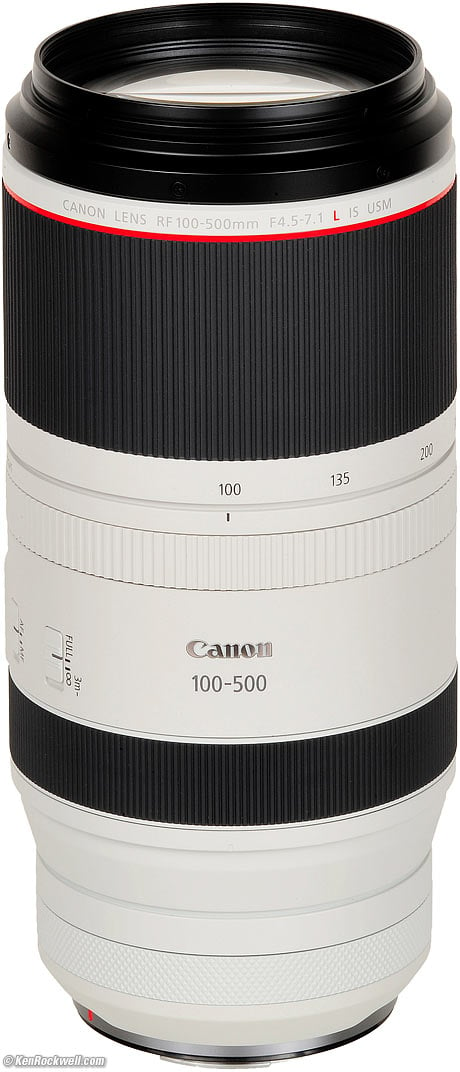 |
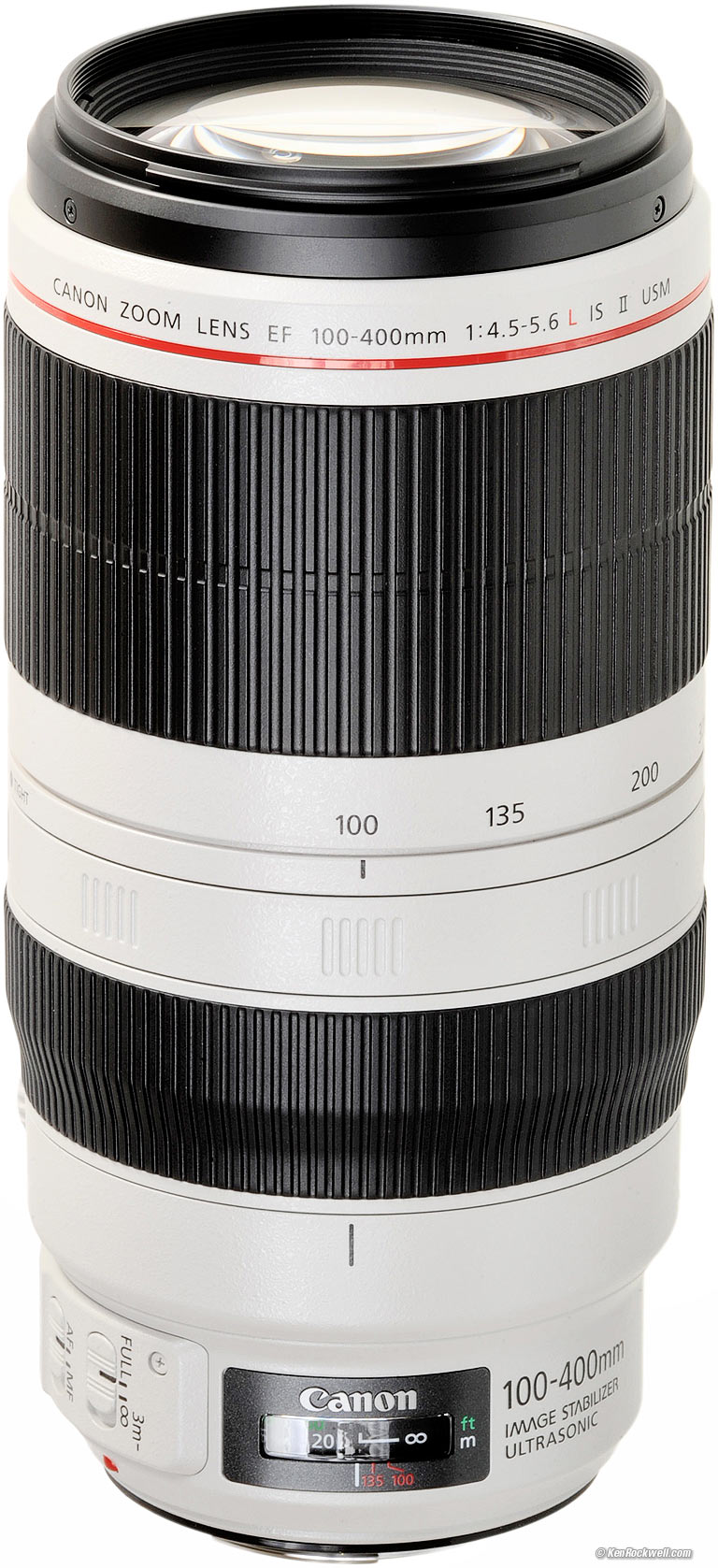 |
|
| Announced | 7/2020 |
11/2014 |
| Maximum Apertures | f/4.5~7.1 |
f/4.5~5.6 |
| Filter size | 77mm |
77mm |
| Filter threads | Plastic |
Metal |
| Length | 8.17" 208mm |
7.6" 193 mm |
| Gets longer as zoomed? | Yes |
Yes |
| Works on Mirrorless? | YES |
YES, with EF-RF Adapter |
| Works on DSLR and 35mm? | NO |
YES |
| Exterior | Plastic |
Metal |
| Interior | Plastic & Metal |
Metal |
| Sharpness | Extreme |
Extreme |
| Fluorite element? | No |
YES |
| AF Speed | Fast |
Fast |
| Full-time instant manual-focus override? | NO, requires menu fiddling and only then works some of the time |
YES, direct mechanical connection |
| Close focus | 2.9'/0.9m at 100mm 3.9'/1.2m at 500mm |
2.75'/0.84m at 100mm 2.75'/0.84m at 400mm |
| Max. Macro Ratio | 1:3 (0.33×) |
1:3.2 (0.31×) |
| Focus distance window? | No |
YES |
| Focus distance shown in finder? | YES |
No |
| Distortion | ||
| Distortion auto-corrects on Mirrorless? | YES |
YES |
| Distortion auto-corrects on DSLRs? | n/a |
YES |
| Works with teleconverters | ||
| Zoom range with teleconverters | only 300~500mm |
100-400mm full range |
| Stack 1.4× and 2× converters? | NO |
YES (with original and -II EF extenders; -III extenders don't stack) |
| Tripod collar included? | YES |
YES |
| Removable tripod collar? | YES |
Only foot comes off; collar remains. |
| Weight w/foot or collar | 54.0 oz. 1,530 g. |
57.0 oz. 1,616 g. |
| Weight, no foot or collar | 48.3 oz. 1,370 g. |
54.7 oz. 1,550 g. |
| Price, 9/2020 | ||
| Price, 03/2021 | ||
| Price, 08/2022 | ||
| Price, 10/2022 |
Versus the RF 70-200mm f/2.8L IS
Canon RF 70-200mm f/2.8L IS USM with Removable Tripod Collar (77mm filters, 41.9 oz./1,187g with collar as shown, 37.5 oz./1,062g without, 2.3'/0.7m close focus, 1:4.3 (0.23×) maximum macro repro ratio, $2,599, or about $2,300 used). bigger. I got mine at B&H. I'd also get mine at Adorama, at Amazon or at Crutchfield, or used at eBay if you know How to Win at eBay.
I prefer this 100-500mm. I always use the 200-500mm range (on Nikon you'd have to buy an extra lens just to cover 200-500mm), and I never miss the small 70-100mm range.
Likewise, I don't miss 2.8. If I want soft backgrounds, I shoot at 500mm. With digital I don't need the fast f/2.8 apertures I did back in the days of film when all I shot was ISO 50 Velvia. On digital, f/4.5~7.1 is swell, for me.
This 100-500mm focuses almost as close as the 70-200mm, and since this lens goes to 500mm, I can get much closer macro results than I can with the 70-200.
Many people are still stuck on the 70-200 from film days, but I moved on years ago to the 100-400, and now the 100-500mm. To each their own.
Versus the RF 100-400mm IS USM
Canon RF 100-400mm f/5.6-8 IS USM.
Like most companies, Canon announced this huge, expensive RF 100-500mm L IS first, so that all the rich people who wanted to buy one would, and so that all the people who wanted a long zoom for their EOS-R series camera bought it if they could afford it.
Once those people paid dearly for this big, expensive RF 100-500mm L IS, then Canon introduced the compact, inexpensive and ultra-high perfomance RF 100~400mm IS USM that is what most people wanted in the first place.
The picture quality is equally superb from either of these lenses Both are ultra-sharp.
The real differences are that one is a huge, expensive beast, zooms a little further, and is an insignificant two-thirds of a stop faster. The RF 100-500mm L IS doesn't work well on extenders; it can't zoom below 300mm (!), while the 100-400mm works at all settings, and works well.
The 100-400mm zooms three times wider on an extender, it's smaller, lighter and has tighter macro. Just get it!
| Filter size | ||
| Maximum Aperture | f/5.6-8 |
f/4.5-7.1 |
| Maximum Macro Ratio | 0.41× |
0.33x |
| Sharpness | Ultra sharp |
Ultra sharp |
| AF Speed | Just about instantaneous |
Very fast |
| Effective zoom range on 1.4× Extender* | 140 ~ 560mm |
420* ~ 700mm |
| Effective zoom range on RF 2× Extender* | 200 ~ 800mm |
600* ~ 1,000mm |
| Prestige | NoëL |
L |
| Length at 100mm | 6.5" 165 mm |
8.17" 208mm |
| Weight | 22.4 oz. 635g |
54.0 oz./1,530g with tripod collar 48.3 oz./1,370g no collar |
| Price, 12/2021 | ||
| Price, 08/2022 |
* 100-500mm lens can only be set to 300-500mm with an extender.
User's Guide top
Sample Images Intro Compatibility
Specifications Performance Compared
I got my RF 100-500mm at B&H. I'd also get it at Adorama, at Amazon or at Crutchfield, or eventually used at eBay if you know How to Win at eBay.
Manual-Focus Override user's guide top
By default, there is no always-responsive instant manual-focus override as we take for granted in our DSLRs.
EOS R cameras need a menu setting changed for manual-focus override, otherwise the focus ring is always ignored in AF.
Find the "Lens electronic AF" option in your AF menu (AF 4 in EOS R5 and EOS R6 or CAMERA 8 in EOS RP), and set it to either "One‑Shot‑>enabled" or "One‑Shot‑>enabled (magnify)."
Canon should have it set this way by default, but they don't. No big deal now that I figured it out.
Now manual focus override works if you turn the ring while continuing to hold the shutter halfway, but only after focus locks in ONE SHOT.
Canon RF 100-500mm f/4.5-7.1L IS USM. bigger.
FULL / 3m-∞ Switch user's guide top
This is a focus limiter.
Leave it in FULL.
The 3m-∞ position prevents the lens from autofocusing closer than 3 meters (10 feet). Use this setting only if you're having a problem with the lens attempting to focus on irrelevant close items, or if for some reason the lens is "hunting" from near to far looking for distant subjects.
AF - MF Switch user's guide top
AF: Auto Focus.
MF: Manual Focus only.
Stabilizer Switches user's guide top
ON / OFF
Leave it ON unless you're on a very sturdy tripod, or if you're making exposures longer than a second on any kind of tripod.
Stabilizer Mode 1 / 2 / 3
Mode 1: Normal.
Mode 2: Panning.
Mode 3: Same as mode one, but saves power by only working when you take the picture.
Tripod Collar user's guide top
The collar comes off by loosening the thumb screw and then pulling it out to unlatch the collar.
Tighten the thumbscrew to lock rotation.
There are no 90º clicks; look at the marks on the collar and the nearly invisible indent on the lens.
Recommendations top
Sample Images Intro Compatibility
Specifications Performance Compared
I got my RF 100-500mm at B&H. I'd also get it at Adorama, at Amazon or at Crutchfield, or eventually used at eBay if you know How to Win at eBay.
This is the best dedicated telephoto for Canon's full-frame mirrorless cameras. It's light and sharp and flexible. Bravo!
The only question is if you already own, or decide instead to get, the also also superb 100-400mm L IS II, to which I have a detailed comparison above. If you already own the 100-400mm L IS II, there isn't much point of buying this one because they both work equally well, and if you're buying new, the question is do you prefer lighter weight and 500mm range (this lens), or sturdier build and better compatibility with teleconverters (the 100-400mm L IS II). Of course you need to use an EF-RF adapter with the 100-400mm L IS II, and they still cost less even if you have to buy the adapter.
I use a clear (UV) protective filter instead of a cap so I'm always ready to shoot instantly. I only use a cap when I throw this in a bag with other gear without padding — which is never. The UV filter never gets in the way, and never gets lost, either.
The best protective filter is the 77mm Hoya multicoated HD3 UV which uses hardened glass and repels dirt and fingerprints.
For less money, the B+W 77mm 010 is an excellent filter, as is the multicoated version and the basic multicoated Hoya filters or the 77mm Nikon Clear (NC - UV), but the Hoya HD3 is the toughest and the best.
Filters last a lifetime, so you may as well get the best. The Hoya HD3 stays cleaner than the others since it repels oil and dirt, and will outlast this lens.
All these filters are just as sharp and take the same pictures, the difference is how much abuse they'll take and stay clean and stay in one piece.
I got my RF 100-500mm at B&H. I'd also get it at Adorama, at Amazon or at Crutchfield, or eventually used at eBay if you know How to Win at eBay.
This 100% all-content website's biggest source of support is when you use those or any of these links to approved sources when you get anything, regardless of the country in which you live. Canon does not seal its boxes in any way, so never buy at retail or any other source not on my personally approved list since you'll have no way of knowing if you're missing accessories, getting a defective, damaged, returned, non-USA, store demo or used lens. I use the stores I do because they ship from secure remote warehouses where no one gets to touch your new camera before you do. Buy only from the approved sources I use myself for the best prices, service, return policies and selection.
Thanks for helping me help you!
Ken.
© Ken Rockwell. All rights reserved. Tous droits réservés. Alle Rechte vorbehalten. Ken Rockwell® is a registered trademark.
Help Me Help You
I support my growing family through this website, as crazy as it might seem.
The biggest help is when you use any of these links when you get anything. It costs you nothing, and is this site's, and thus my family's, biggest source of support. These places always have the best prices and service, which is why I've used them since before this website existed. I recommend them all personally.
If you find this page as helpful as a book you might have had to buy or a workshop you may have had to take, feel free to help me continue helping everyone.
If you've gotten your gear through one of my links or helped otherwise, you're family. It's great people like you who allow me to keep adding to this site full-time. Thanks!
If you haven't helped yet, please do, and consider helping me with a gift of $5.00.
As this page is copyrighted and formally registered, it is unlawful to make copies, especially in the form of printouts for personal use. If you wish to make a printout for personal use, you are granted one-time permission only if you PayPal me $5.00 per printout or part thereof. Thank you!
Thanks for reading!
Ken.
